November 9
Nine o’clock takeoff for the market in Leishan. You can tell that it’s getting towards the end of our trip because the group seems more interested in shopping at the market than photographing it. Interesting variety of stuff, some purchases by group members and some photo opportunities, but not one of our more memorable activities.
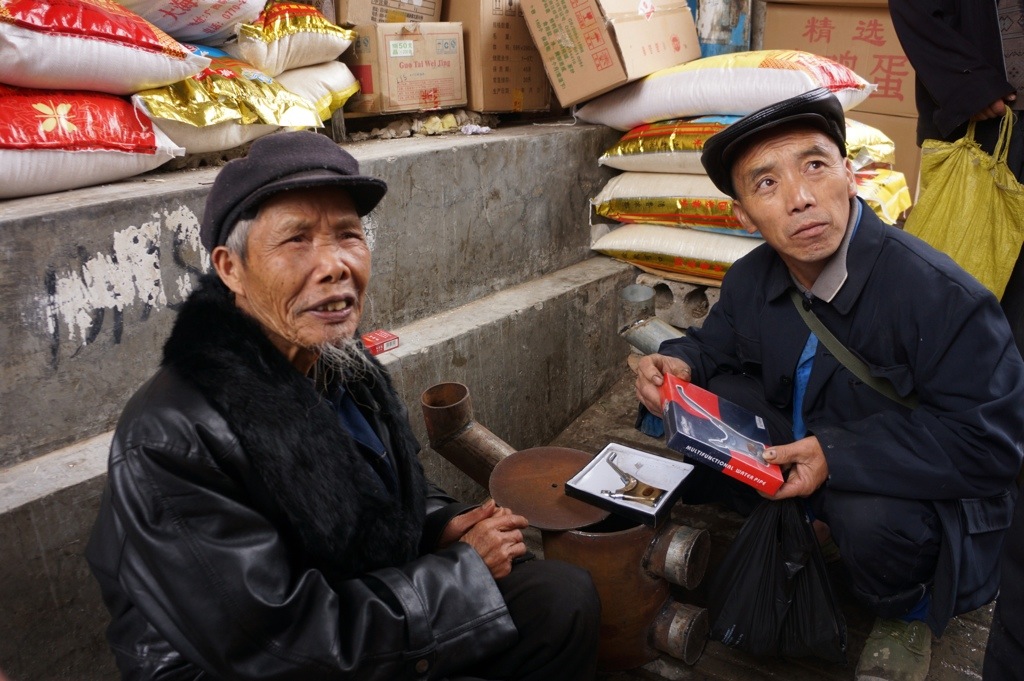
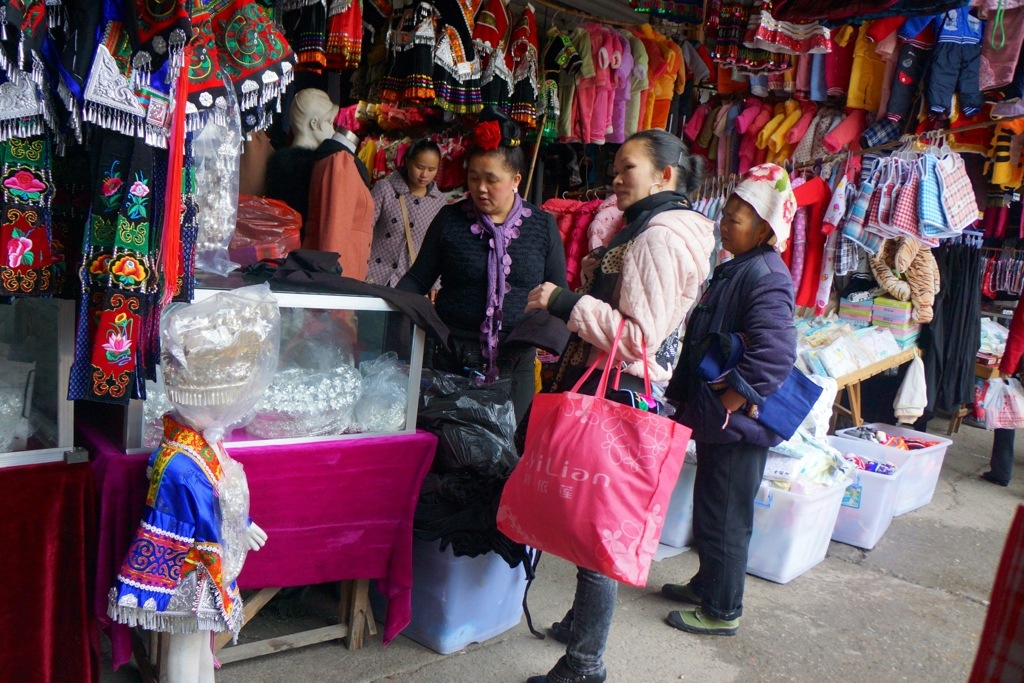
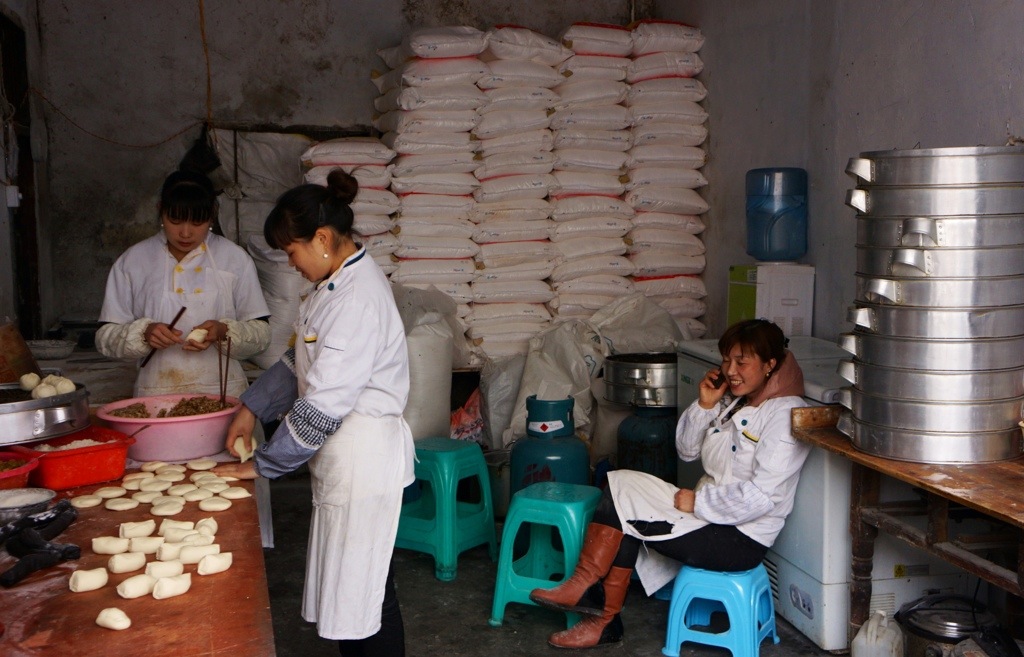
We drive to Kaili for lunch. I stick to my peanut butter lunch routine. I’ve discovered I’m a one-Chinese-meal-a-day guy. During bus rides, Nevada sometimes talks about photographic matters and/or reads from Internet cites about current events.
After lunch, we go to a festival at Chong-an to see the Gejai people and Red Miao people, whose costumes differ from those we’ve seen before.. There’s a light mist, and we’re back to walking through mud again, but not as muddy as our prior festival. The atmosphere and look is more of a fair, than a festival. There are horse races, dog fights and bull fights. The horse races are not as good as those we saw at the other festival and, happily, I saw only dog threats, not dog fights. I did not try to make my way into the bull fighting area, which seemed quite crowded. Near the end, there were performances up on a stage, but that, too, was crowded and as we were on our way out and rather spent, I didn’t really see much of that, either.

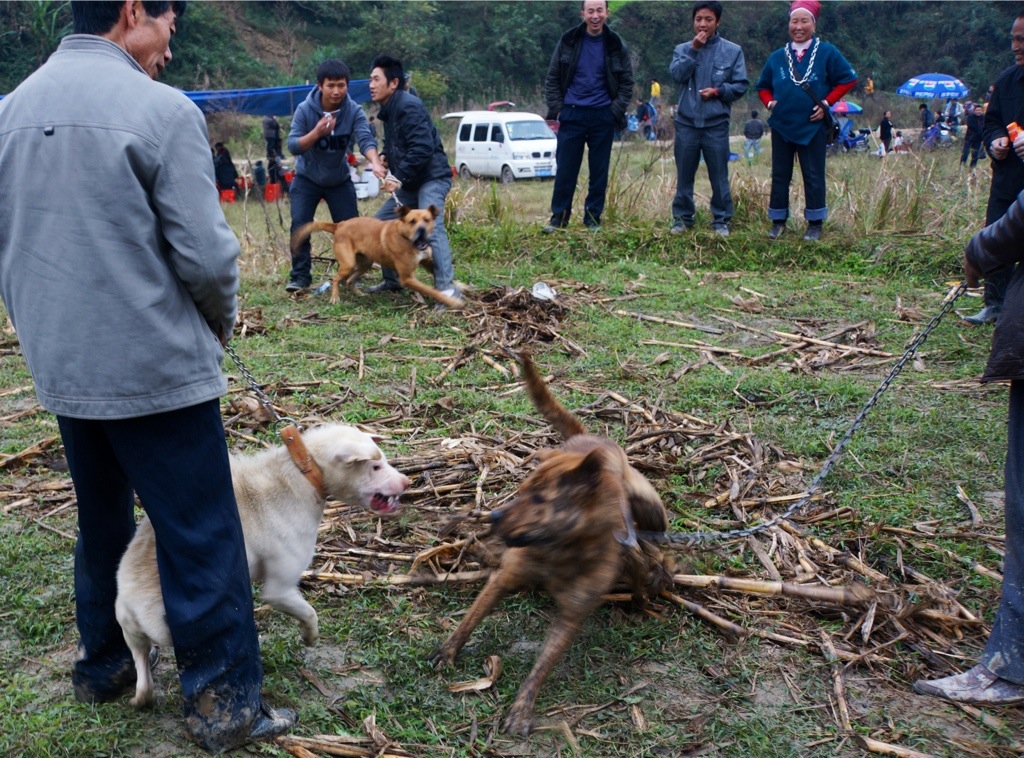
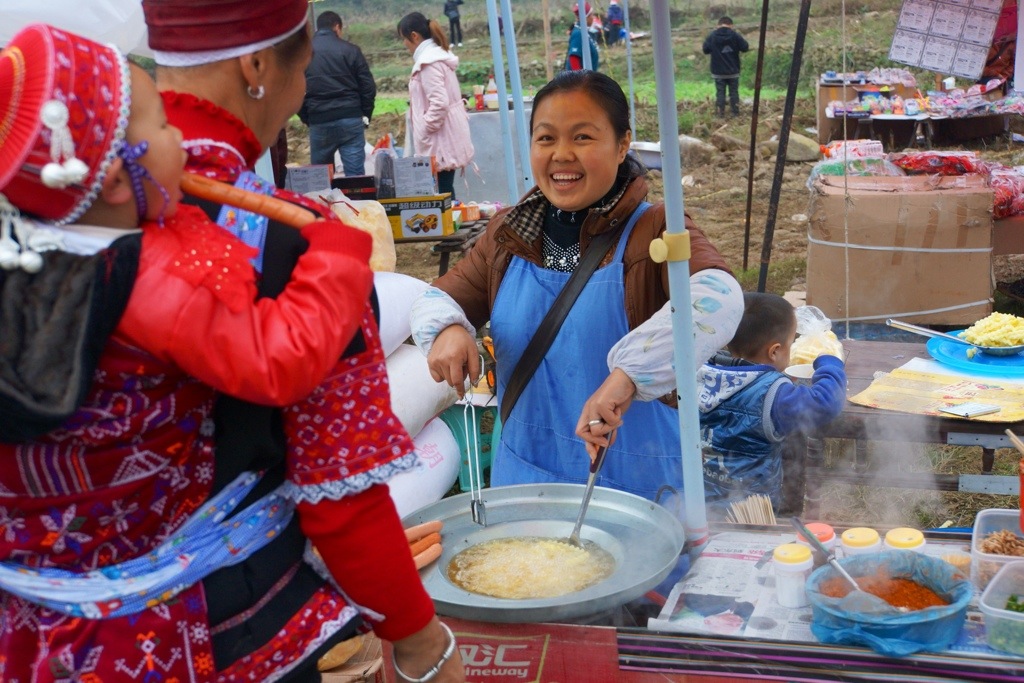
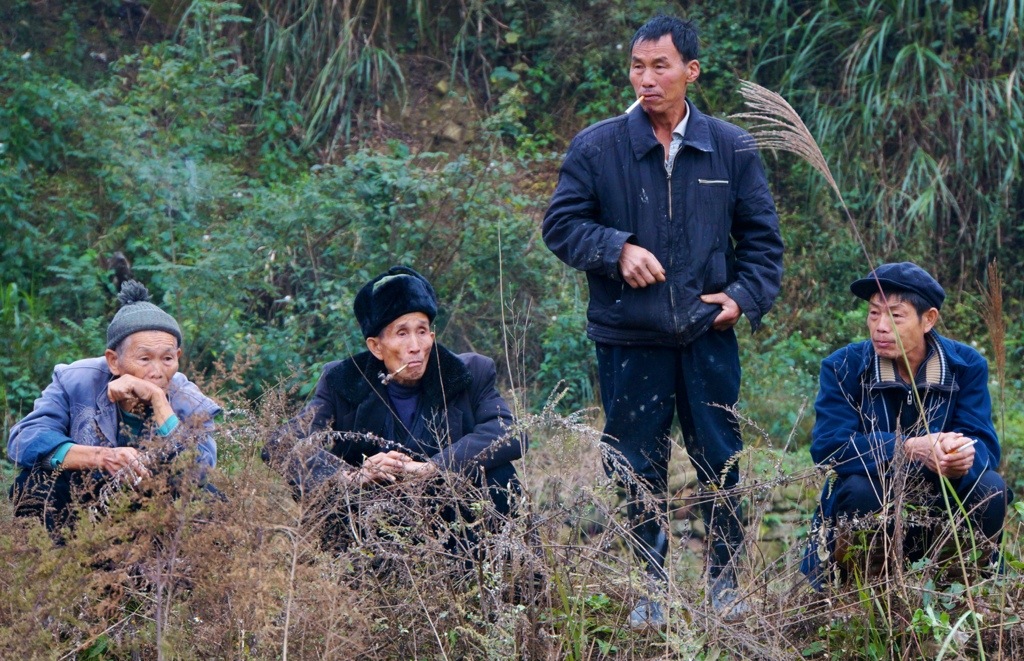
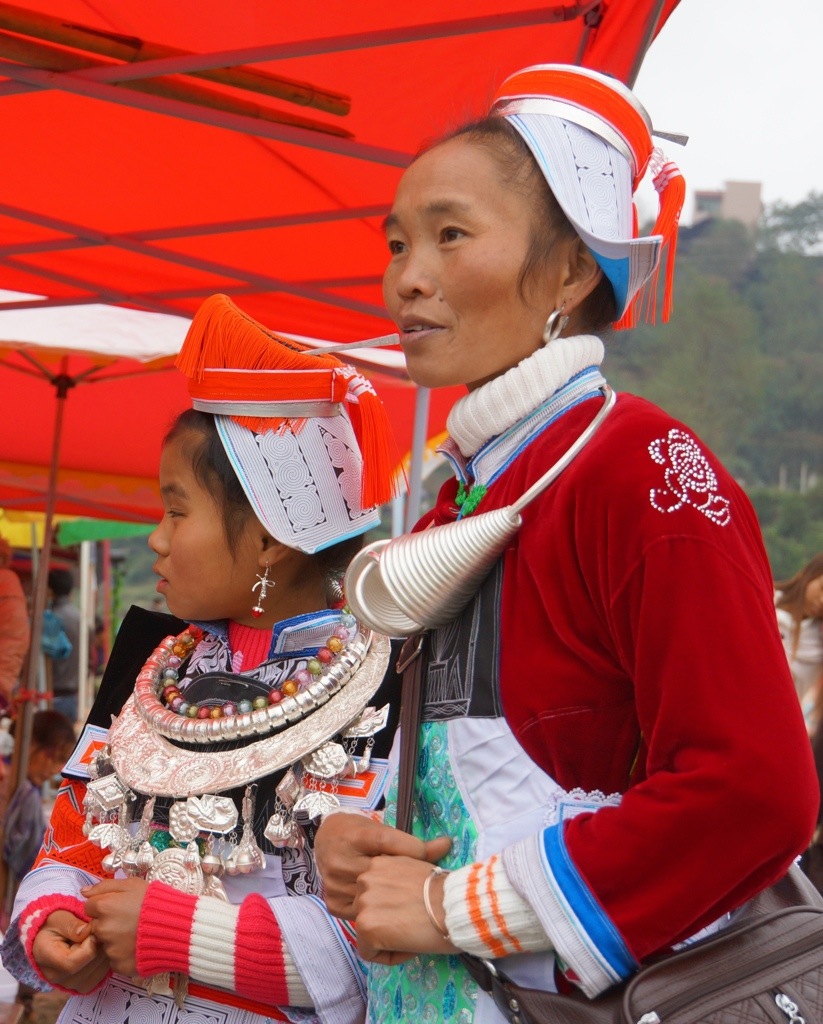
The unanimous consensus of the group is that this was the least interesting of the festivals we’ve seen. But we’ve been spoiled by some very good ones and, hey, not every festival can be a winner. Far fewer, and less interesting, photos today than on the rest of the trip. Speaking of “fewer”photos, at lunch today, Nevada mentioned that she’d taken about 8000 photos on this trip so far. I thought that I’d taken an incredible number, and I’m probably around 2000.
It’s good to get to our hotel, the Jintai Yuan Hotel, where we’ll spend our last three nights. We get the hell out of our muddy and somewhat damp clothes, take a hot shower in our comfortable rooms and go down for a very good dinner in the hotel.
November 8
Bring down our laundry, which we hope this time will be delivered tonight, dry, and we set out at 9:30. The day is overcast, but not rainy, and warmer than yesterday.
I think the group is still winding down from the presidential election, and following the aftermath with interest. Quite a contrast to be in China at this time, which coincides with their once-a-decade change in power that seems to be of little import, and at best passing interest to the populace here. The forces of globalization and the Internet are changing things here, but not very damn fast, in a political sense, at least.
No festivals today, but we stop and walk around four different villages. Just walking around and photographing is quite interesting and satisfying. All of the villages are inhabited by Long-skirt Miao people. In general, everyone is very friendly and inviting, though, not surprisingly, occasionally people do not want their pictures taken.
In the first village, on the outskirts of Leishan, we see people making simple clay bowls. Unlike other trips, when going to see a craft means attempts to sell you the crafts, this is not the case in any of the villages we visit today. I am with Nevada and watch where and what she shoots. She is happy to talk to me about what she is thinking/doing, which is helpful to me.
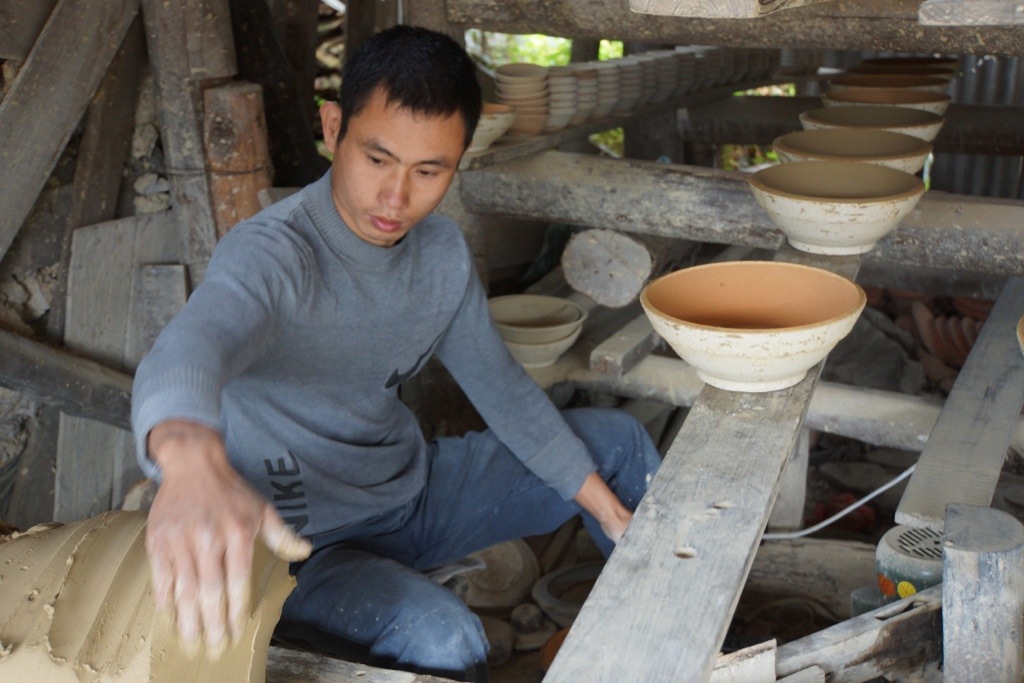
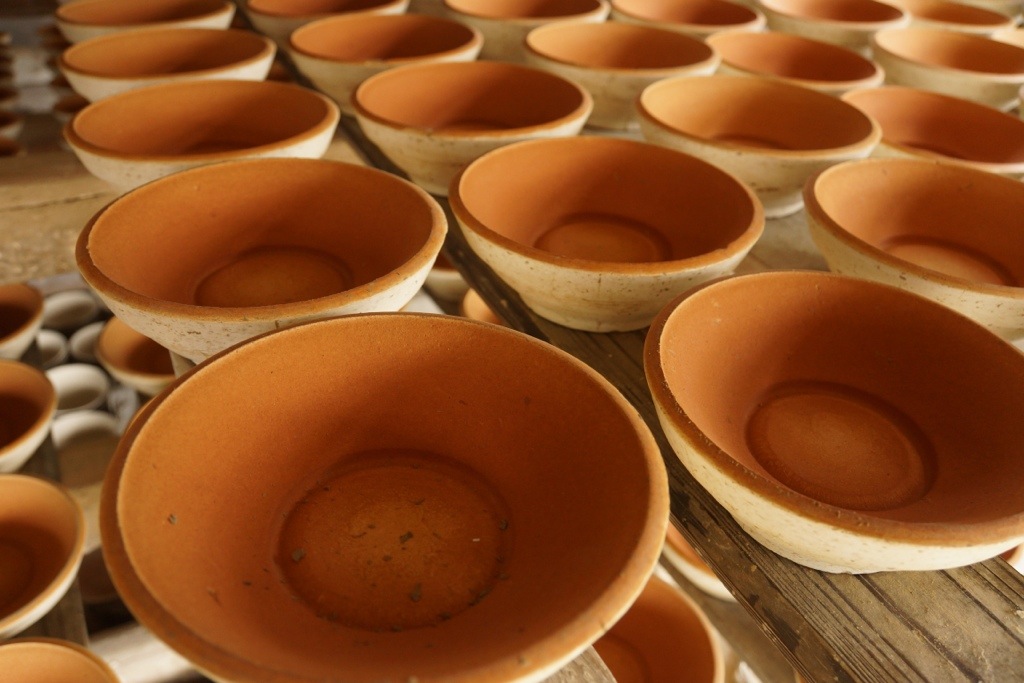
In the next village, Paiki, we see people making lushengs, the wooden-piped musical instruments played in the festivals we’ve been to. This is literally cottage industry, as it’s made by people in their home. One of the craftsman plays Auld Lang Syne for us. Across from this very lovely village a huge instruction project that looks like apartments is going up. In a couple years, this area may have changed pretty dramatically. China is focused on developing its western region and in moving people from the country into cities.
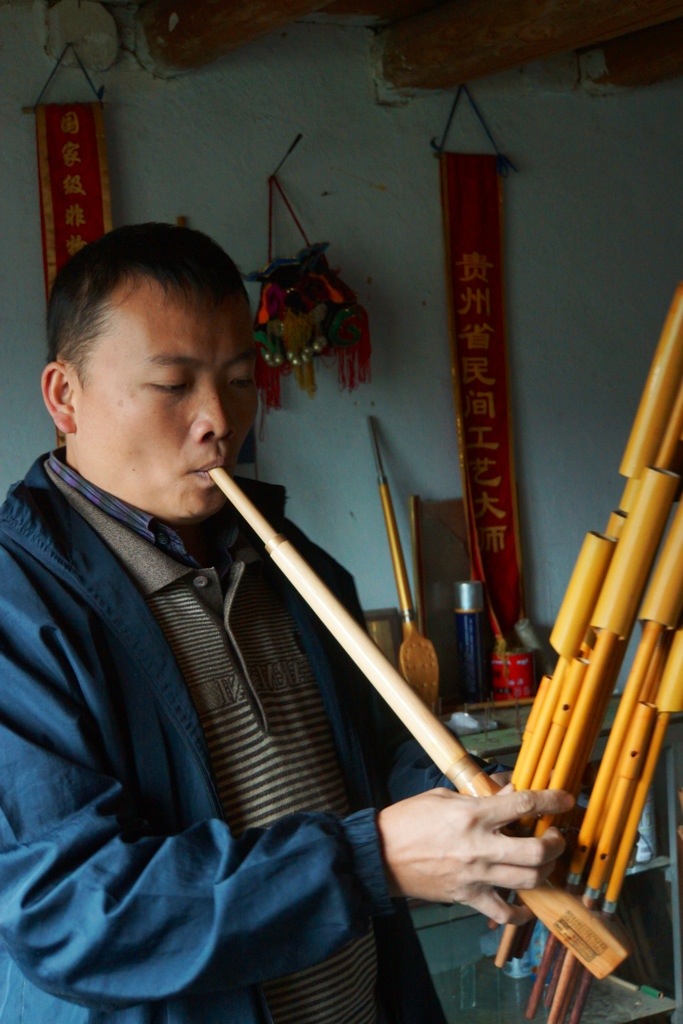
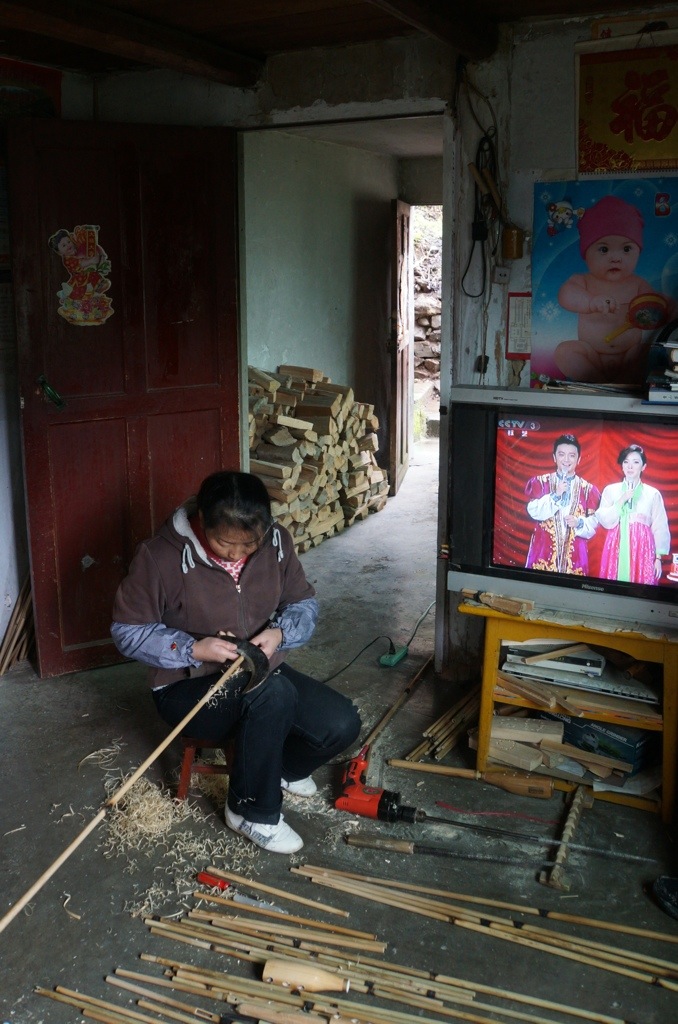
We walk around a third village, then stop for lunch at a restaurant, before heading to Zhang-Ao, which is known for copper drum dances. There Lee arranges to have the headman assemble a group of dancers and a drummer to perform for us. The costumes are quite wonderful and the dance interesting. Many in our group enjoyed this more than I did. Although the dance is an authentic dance that is still performed, the whole thing felt (and was) staged.
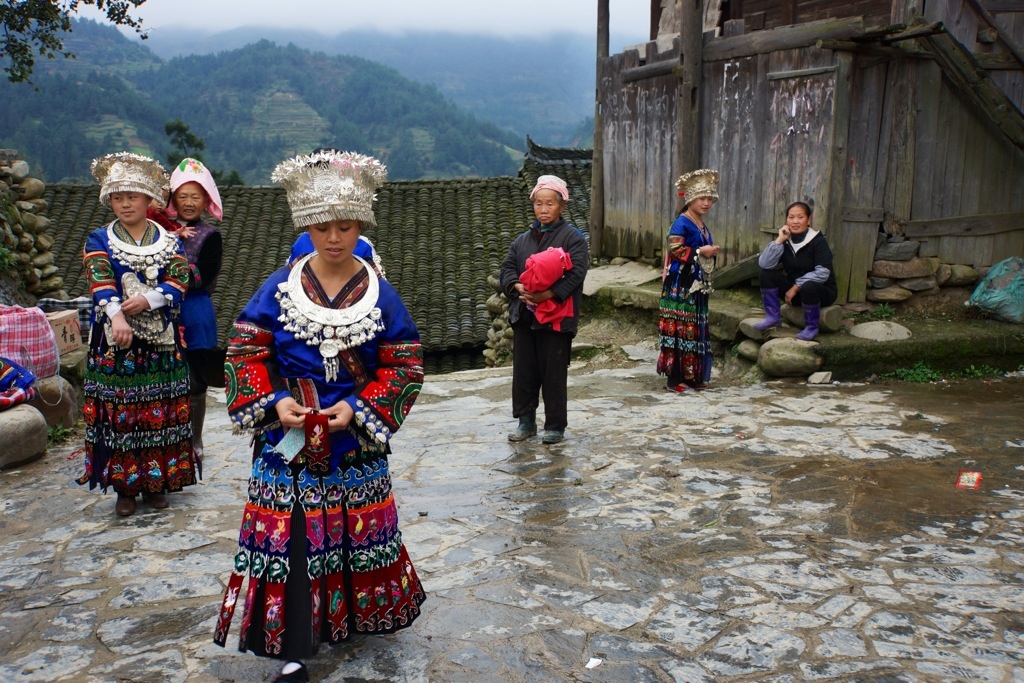
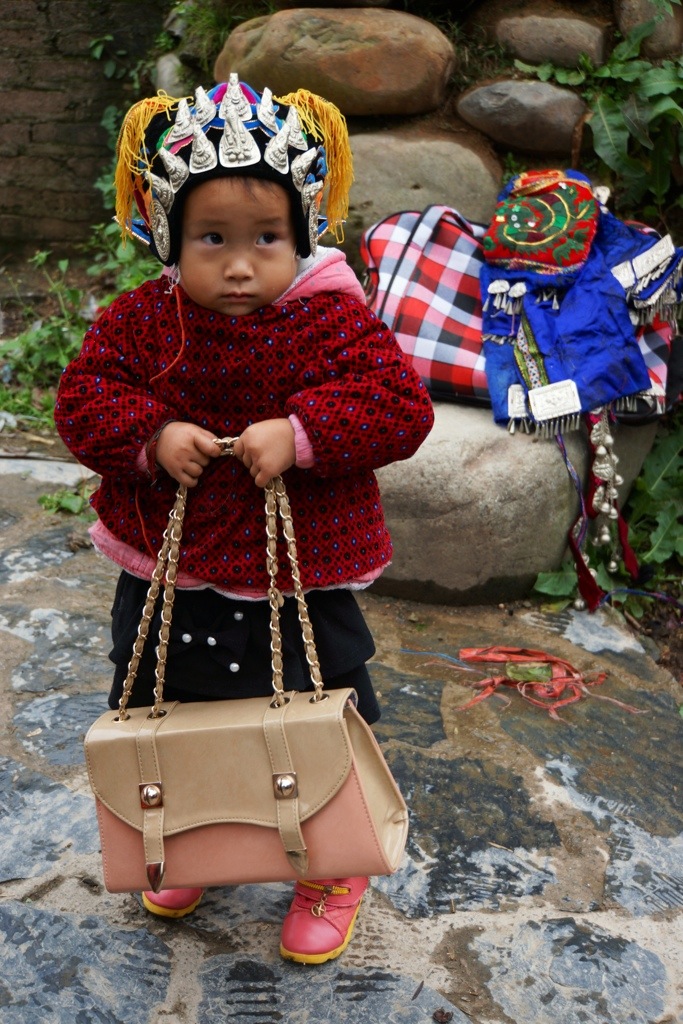
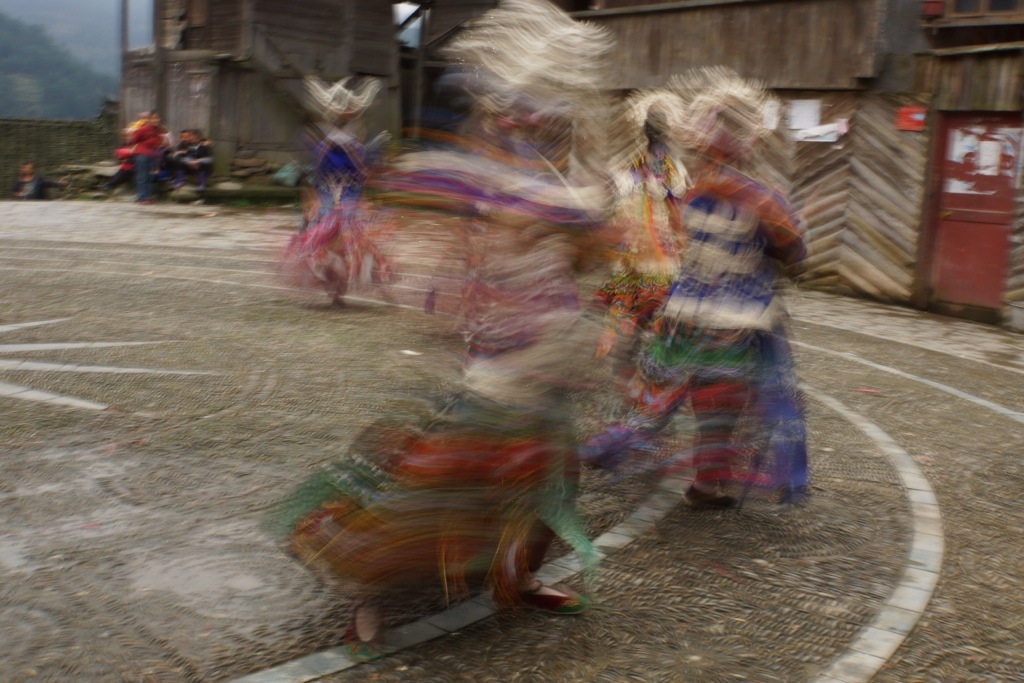
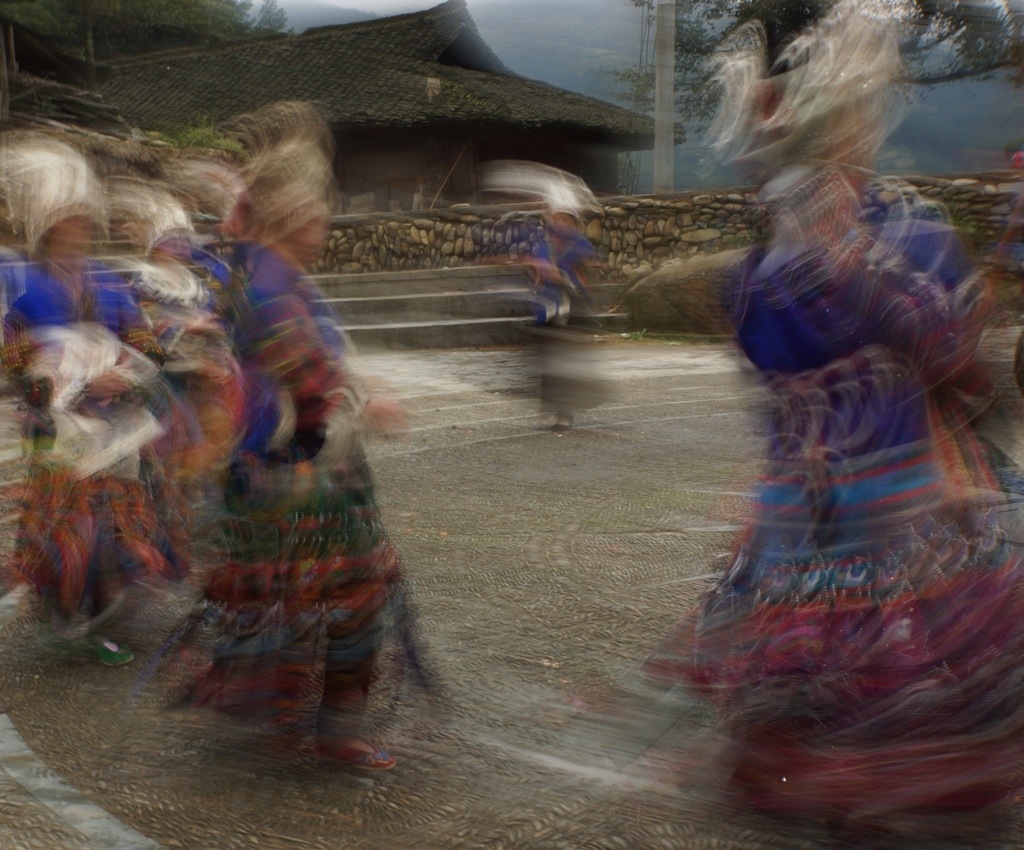
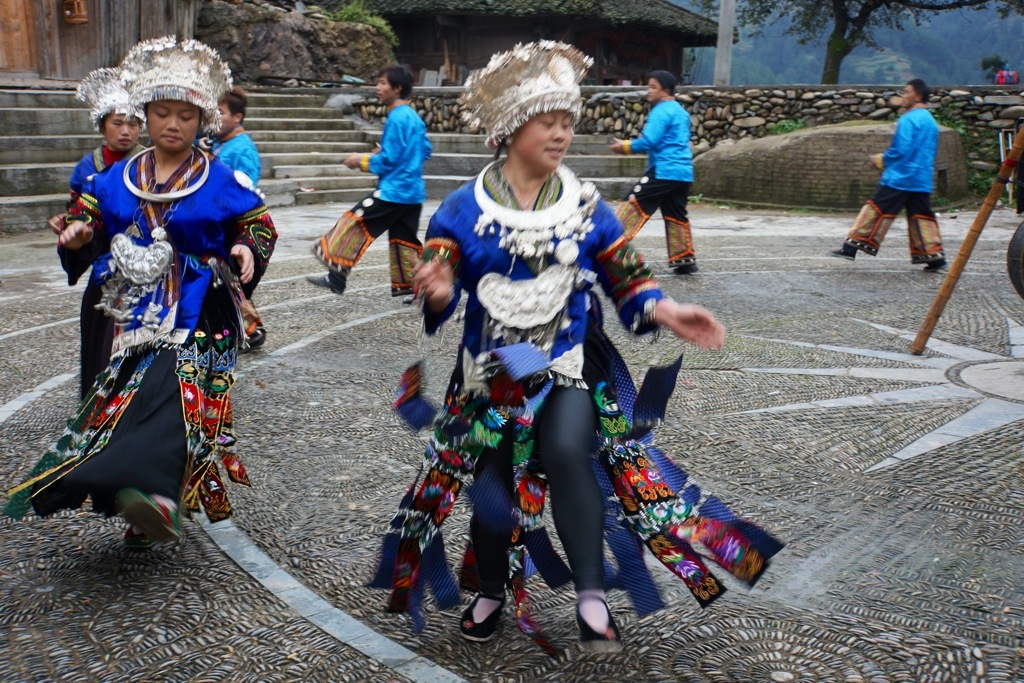
I far prefer the scenes we see walking around villages. People sitting about, the rice being separated from the chaff in a dusty old house, a shaman singing a melody and performing a ritual to help the son of a family, whose soul has been stolen by a demon, a man with his song bird in a cage and a lady with her cat. Here are some of those photos, taken from various of the villages we visited.
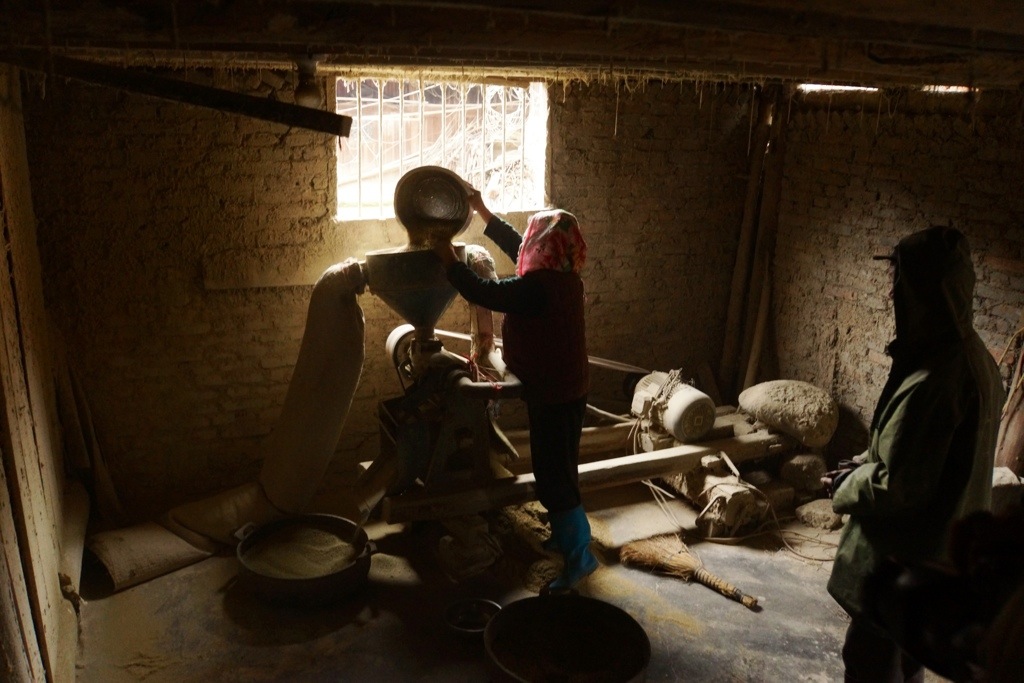
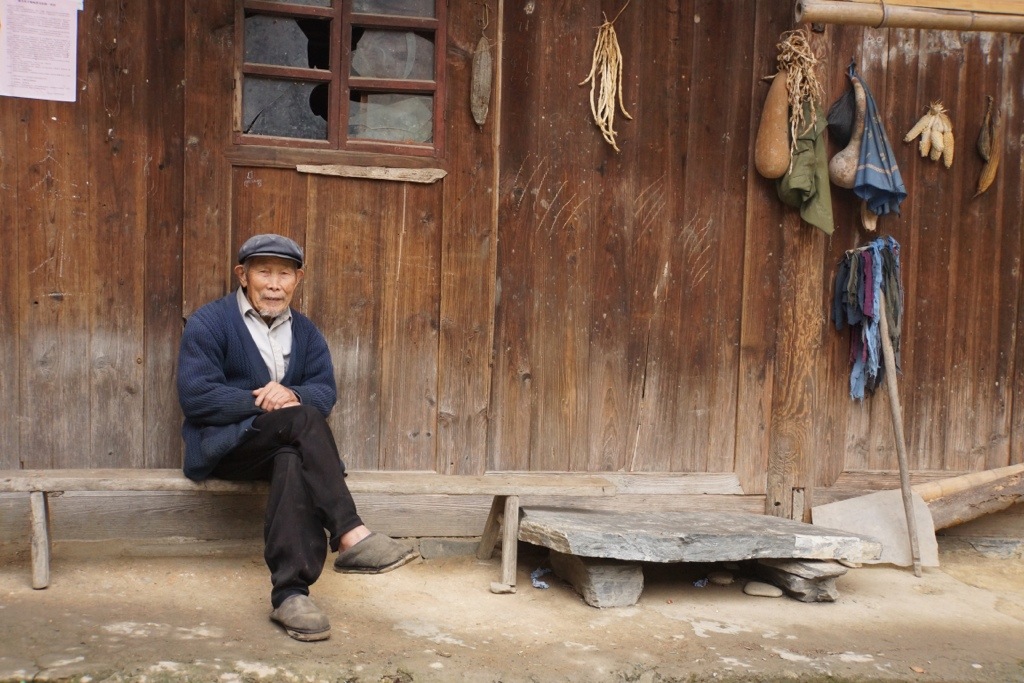
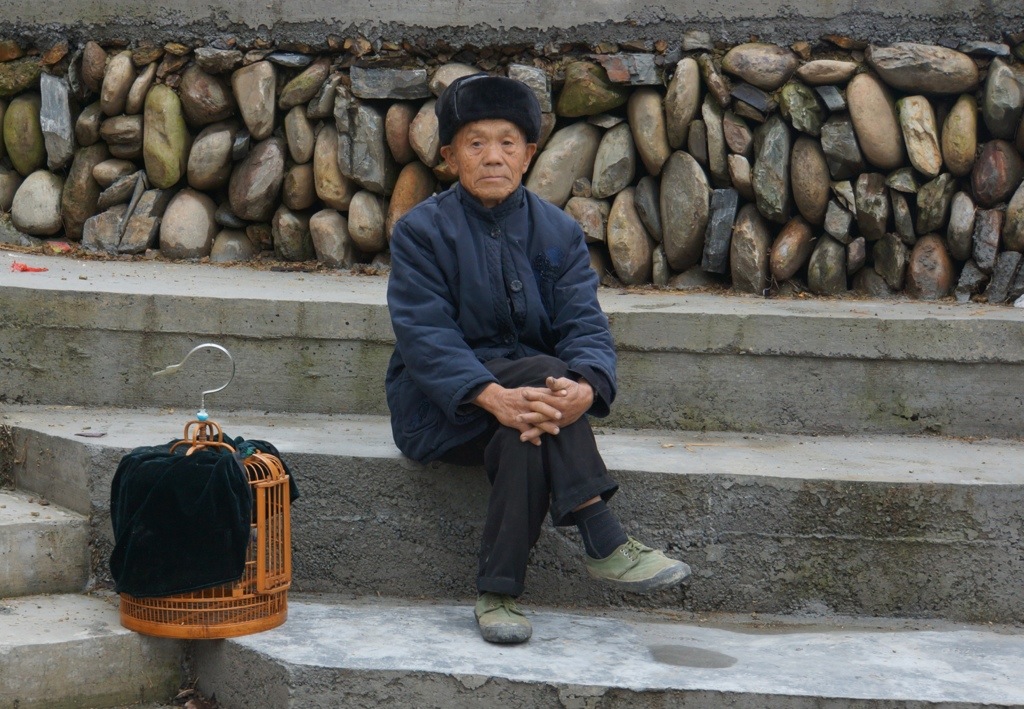
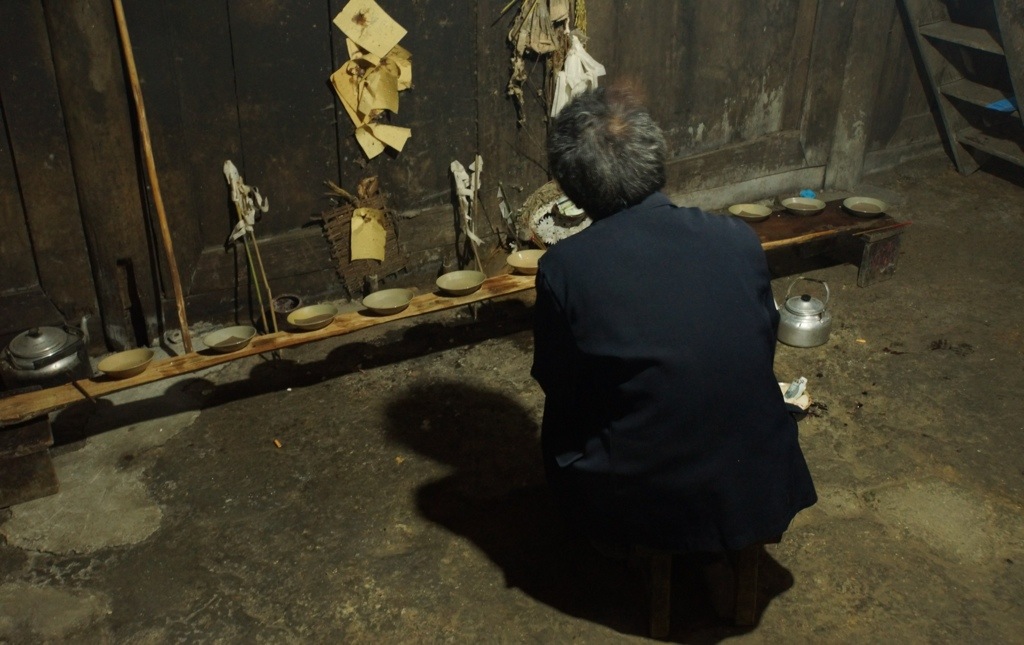
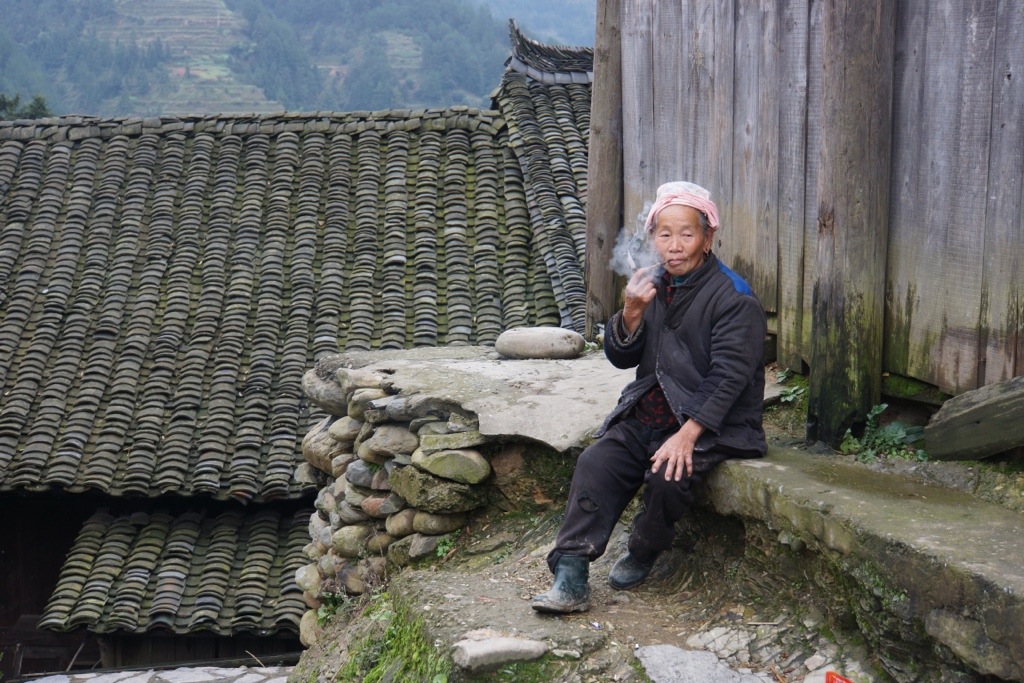
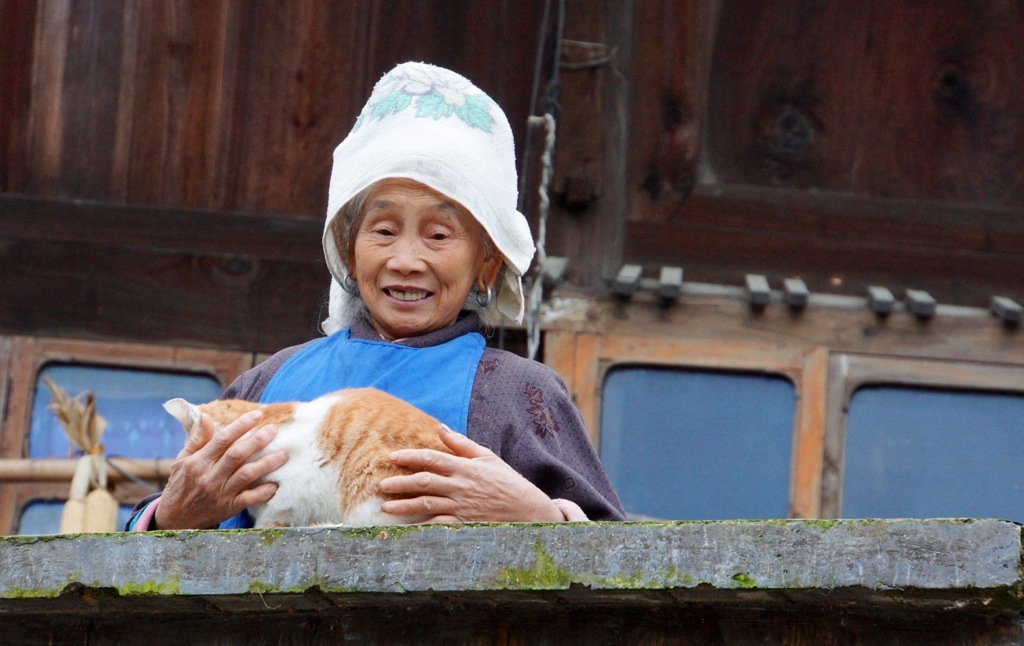
Again, we arrive back at the hotel by five and have two and a half hours before dinner, which we again have at the hotel.
November 7
Pack, breakfast and prepare for a very civilized 9:30 departure. Good, Western-style breakfast, with forks; yessss! We run errands and shop in a light drizzle in Kaili this morning. It’s a nice change of pace, and fun to wander the department store aisles with Chinese shoppers. Most of us pick up little treasures; red socks and a small thermos cup for me. I think my poor camera feels neglected as I’ve managed only about half a dozen pictures by noon. I offer only a couple for today, one of the department store and one an intentional blur of a street scene in the rain.
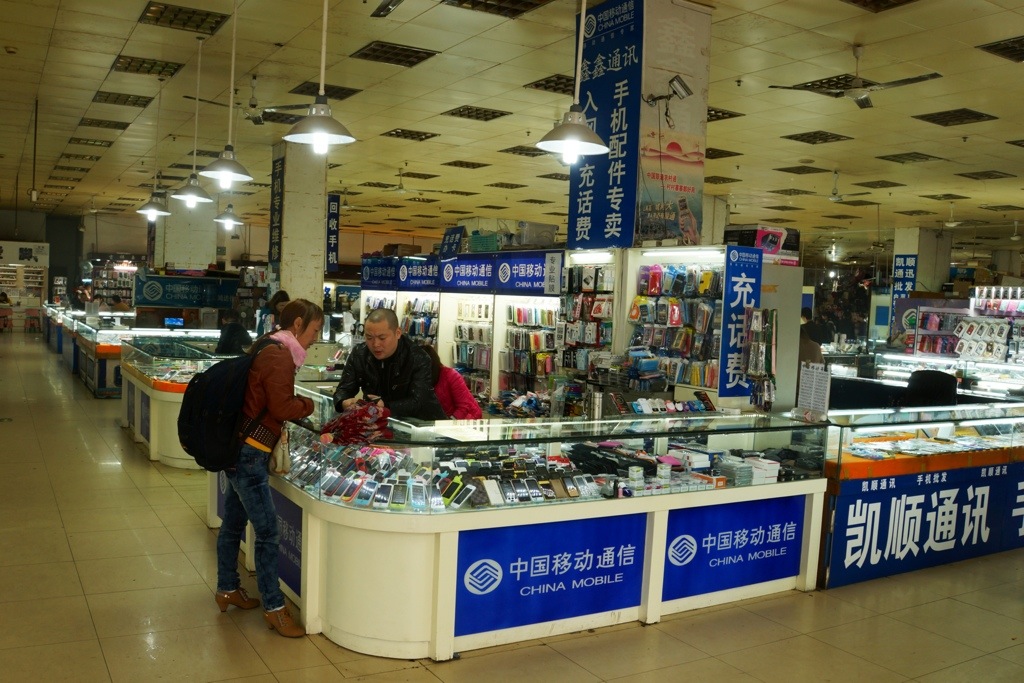
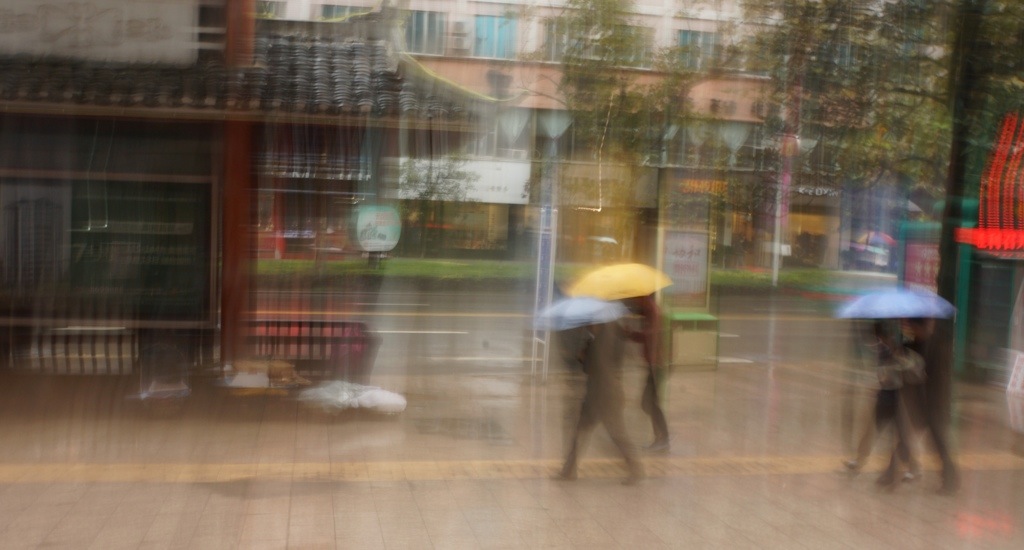
Drive to Madam Yang’s Museum, called The Sun Drum Miao & Dong Costumes Museum, an absolutely extraordinary collection of exquisite textiles and jewelry of Miao, Dong, Yao and other peoples. Each piece is a work of art and the three floors of rooms are all beautifully displayed and lit, with descriptions in English of the costumes, and who wears them for what occasion.
Madame Yang used to be in charge of buying textiles for the Kali Museum that we visited on the first day. She left to pursue her passion for this work and has built a fabulous collection, only part of which is displayed in the museum. She hopes to build a new, larger museum.
Down in the gift shop, we learn that Obama has won, so there is great celebration and relief among our group. I think that Madam Yang benefits greatly from the president’s win, as the good feelings pour over into the group purchasing several thousand dollars of textiles and jewelry from the gift shop, that we might have forgone had the election gone the wrong way. Aside from getting some very nice, quality work, we feel good about supporting Madam Yang’s efforts at the museum.
We have a late lunch not far from the museum, then drive to Leishan, arriving by 5 PM, staying at the very comfortable and modern Leigongshan International Hotel. We have a luxurious two and a half hours off before our very good dinner at the hotel.
Today was chilly and rainy all day, a perfect and much-needed day off for everyone, especially after yesterday’s mud bath. I expect that we’ll all be ready, if not rarin’ to go, tomorrow.
November 6
Election day, back home, though as we’re about twelve hours ahead, we won’t get results until tomorrow. There’s been much talk and concern about the outcome, as we discovered early-on that all of us were Obama supporters.
Near the hotel we encounter a funeral procession about to start. A live rooster was on the top of the coffin. Later, on the bus, Lee explains that the rooster gets detailed and specific instructions from the shaman on where to guide the deceased’s spirit after death. The rooster is then killed by the shaman banging it’s head against the coffin.
Later, the coffin is covered in bright colors with a paper mâché man on top of it, men dressed in white, musical instruments, lines of large, round wreaths start down the street as we photograph.
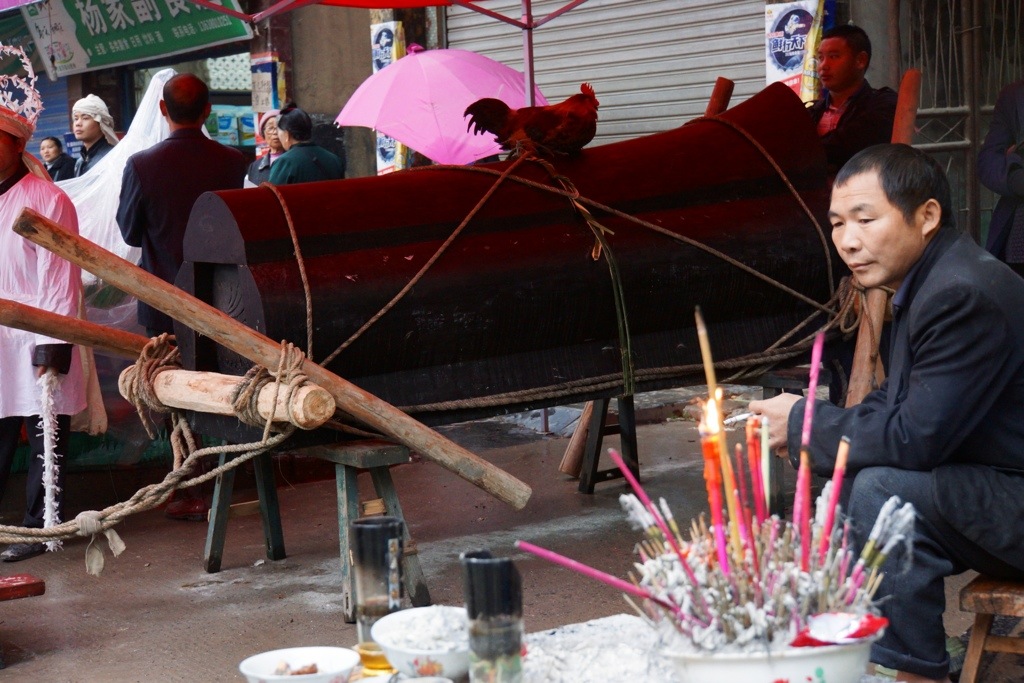
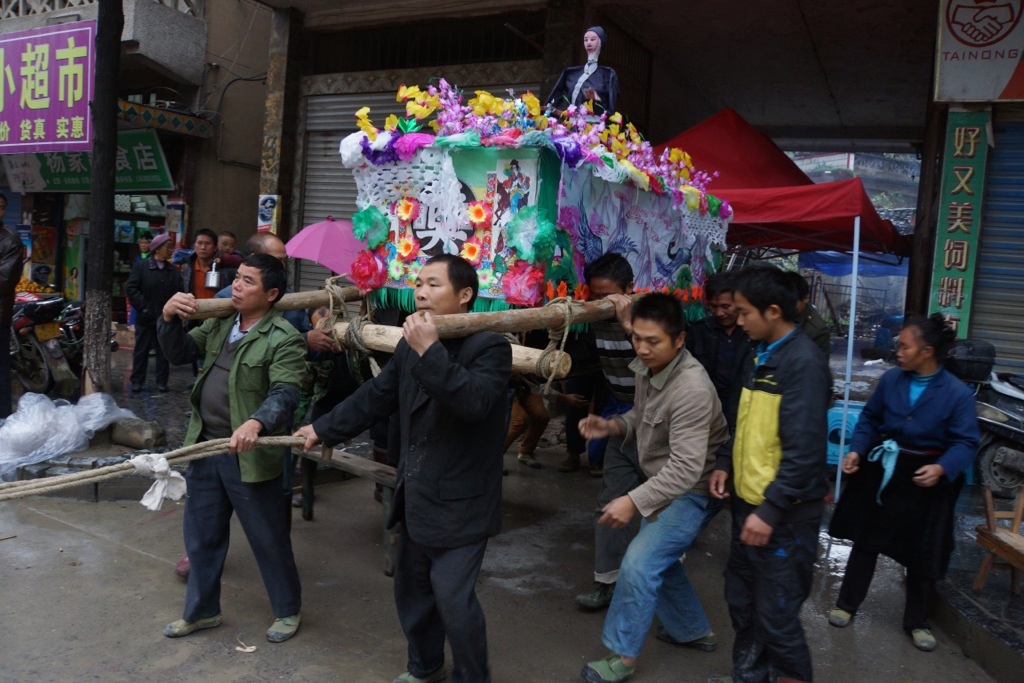
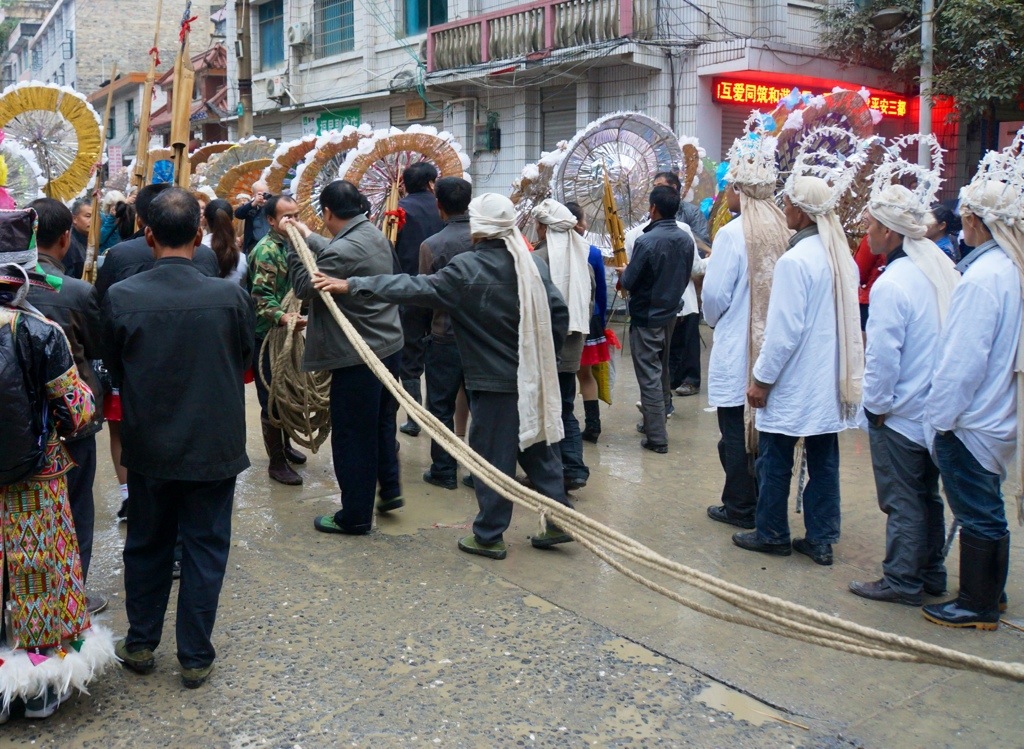
Noodle, soup and fried egg breakfast in small, storefront restaurant, a pit stop back at the hotel, then a ride to the Sui Festival we were supposed to attend yesterday in Longtai Village. We spend time walking around the village and taking photographs of people, some on their homes.
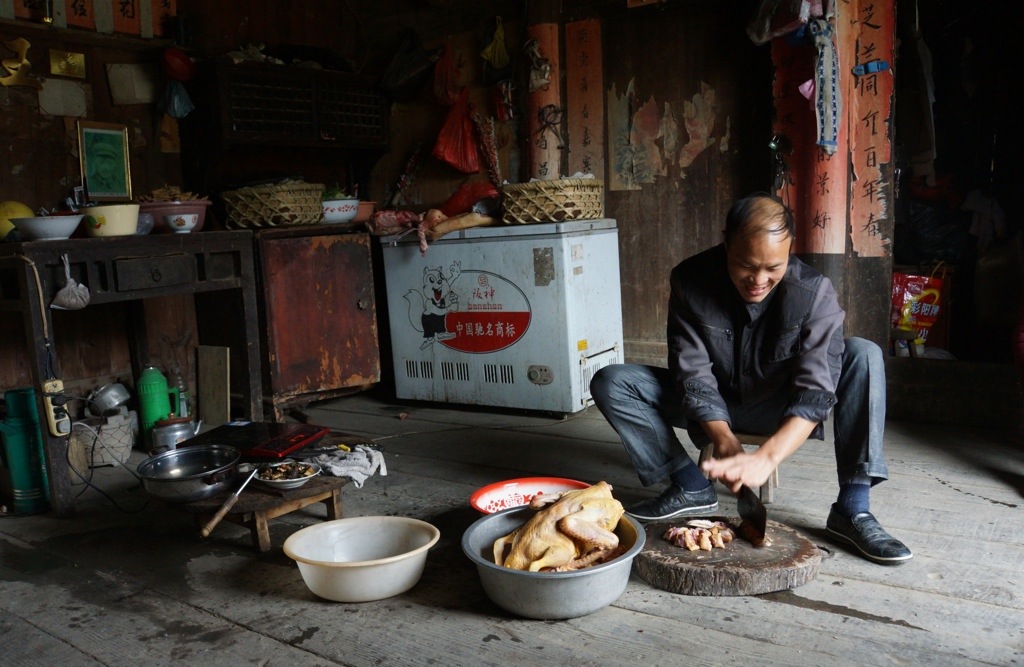
We then head down to where the festival will be held through some serious mud. Not long after we get to the festival area, it begins to rain, so we finally get a chance to don the umbrella hats that we bought on the first day. Here’s Lee in her hat.
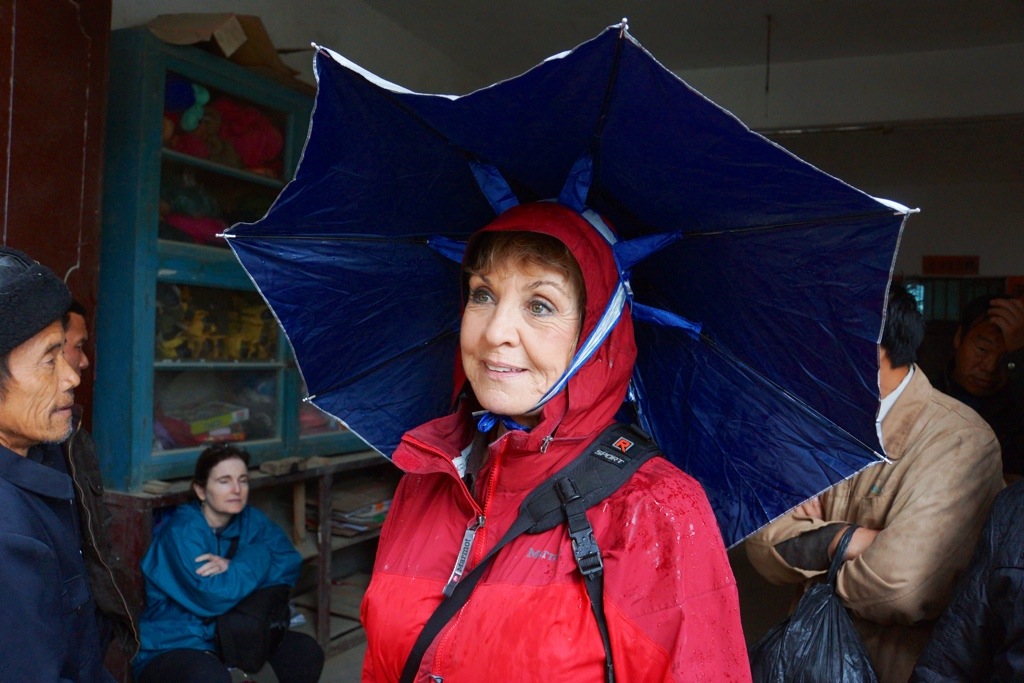
We look pretty goofy, good subjects for Chinese photographers. But the damn hats work and we’re all quite pleased with our $2.50 purchase.
We walk up to a restaurant for lunch, peanut butter and crackers for me, as three Chinese meals in a day is one or two over my limit. A table of Chinese toast Obama.
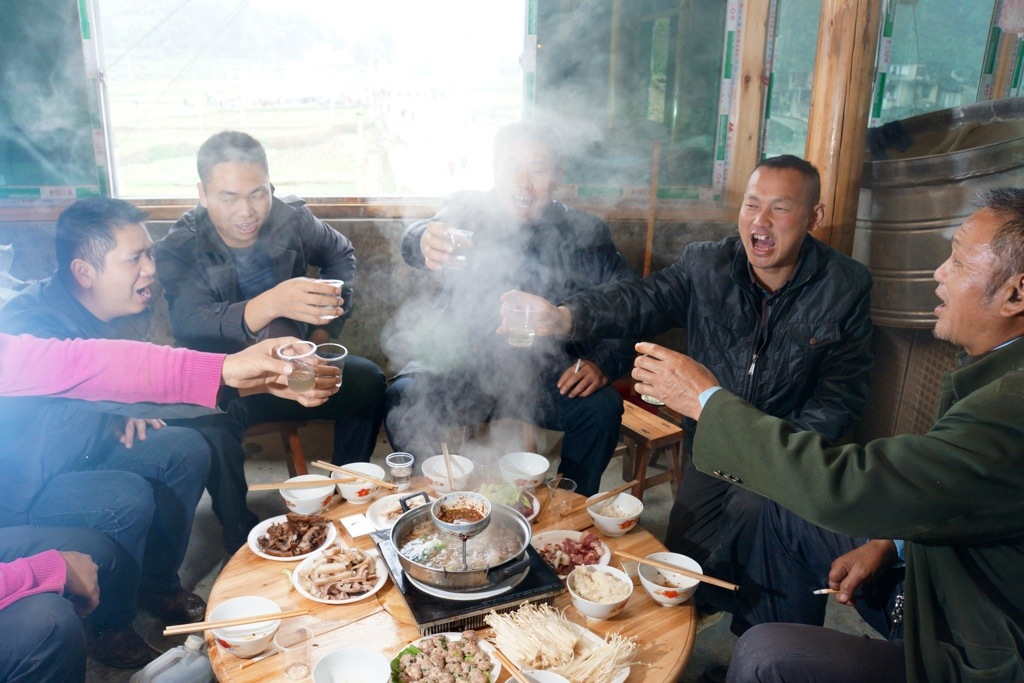
After lunch, we head down to the area where there will be horse races. We encounter a shaman, named Wang Hui Bing, who has just completed an offering. He is cooperative in posing for photos.
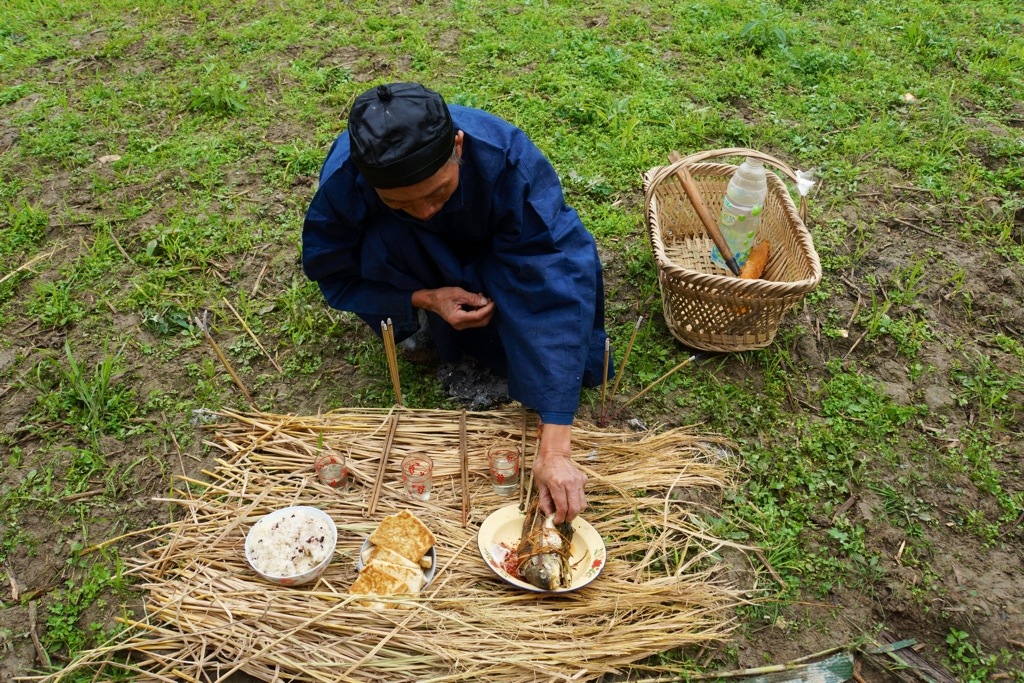
The mud cakes our shoes and splatters our clothes. It’s difficult to pick one foot after another out of the mud.
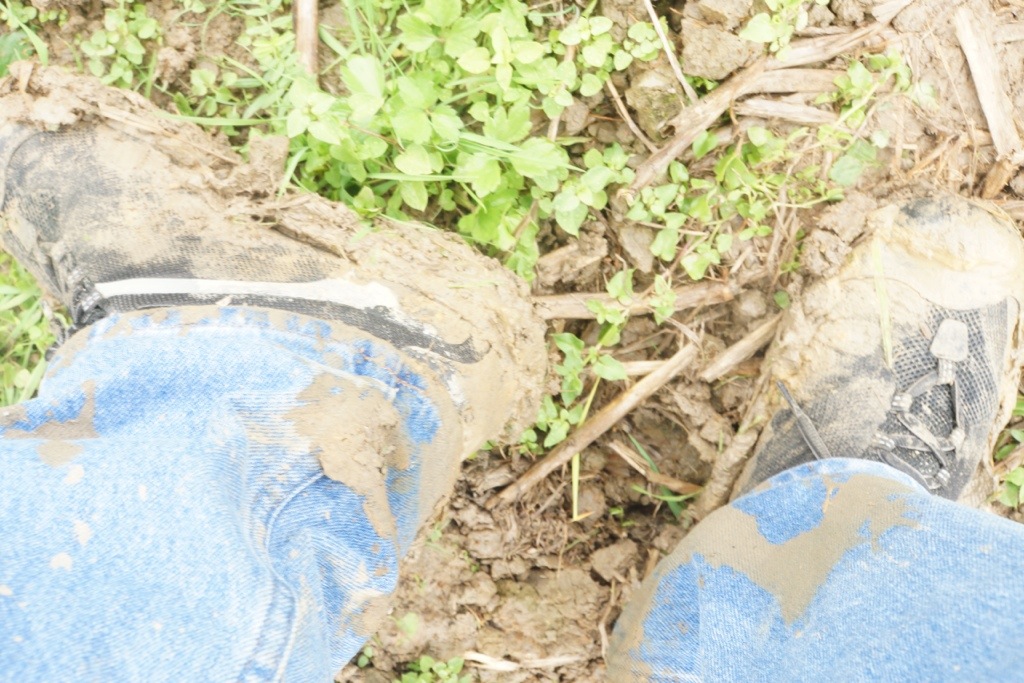
We wait for the start of the horse races, which are down a narrow mud lane lined by flags. Riders are bareback, and some of the horses are unruly, and difficult to mount.
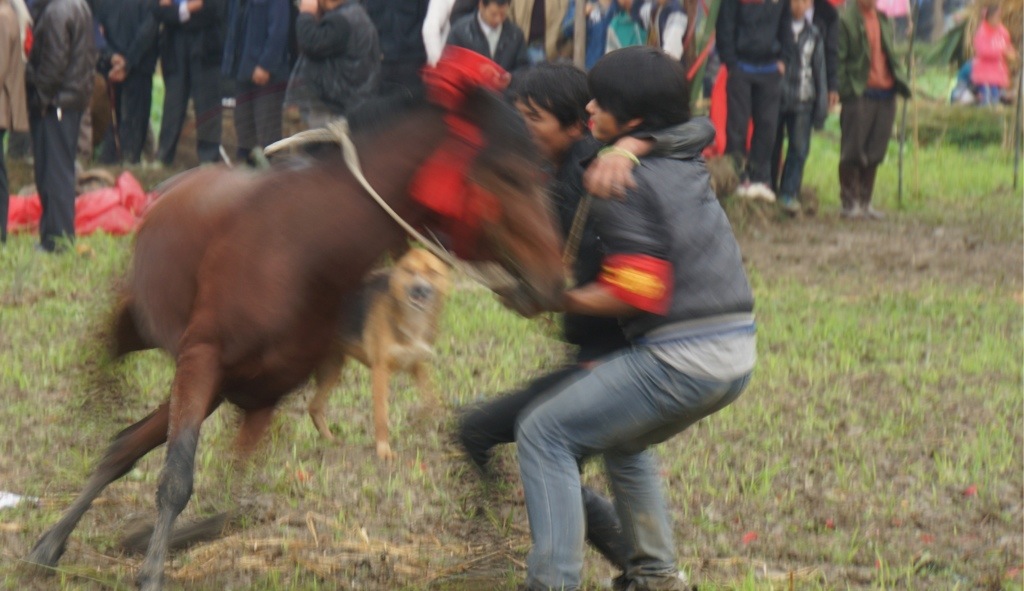
One or two take the riders off the track, and one rider is thrown. The horses practice one at a time, then race in twos and threes, great fun to watch.
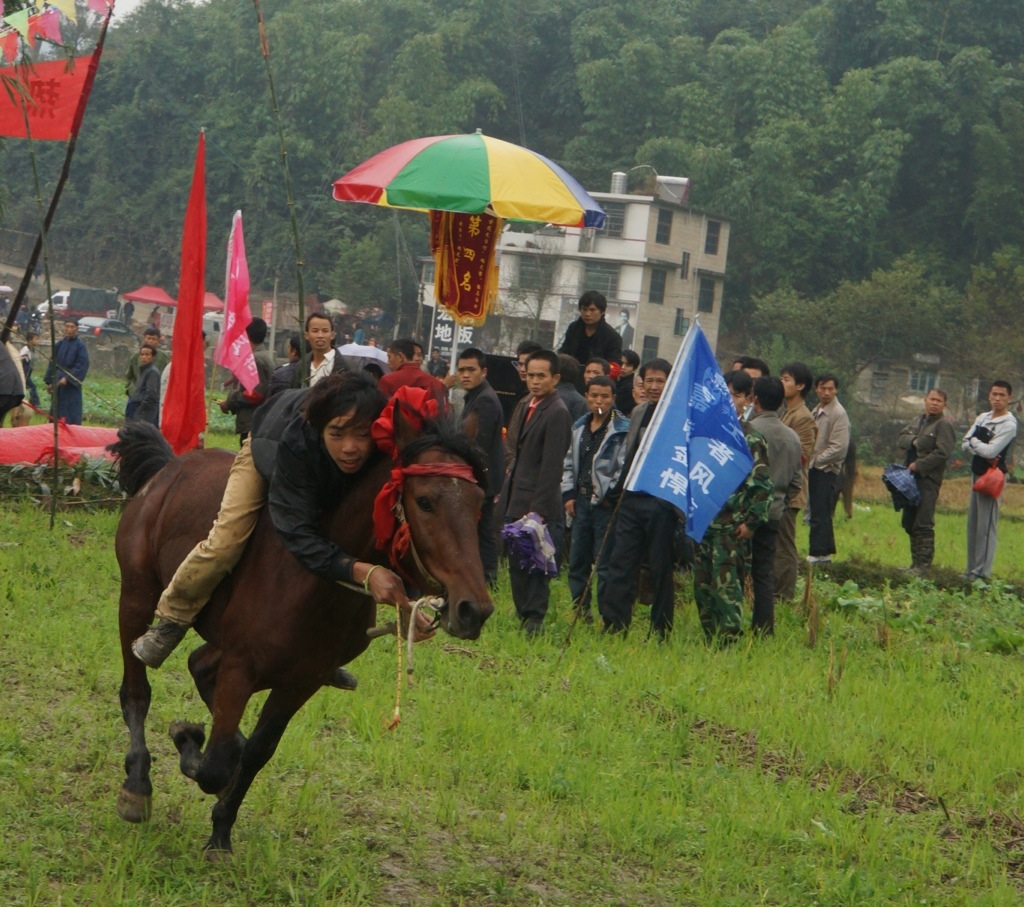
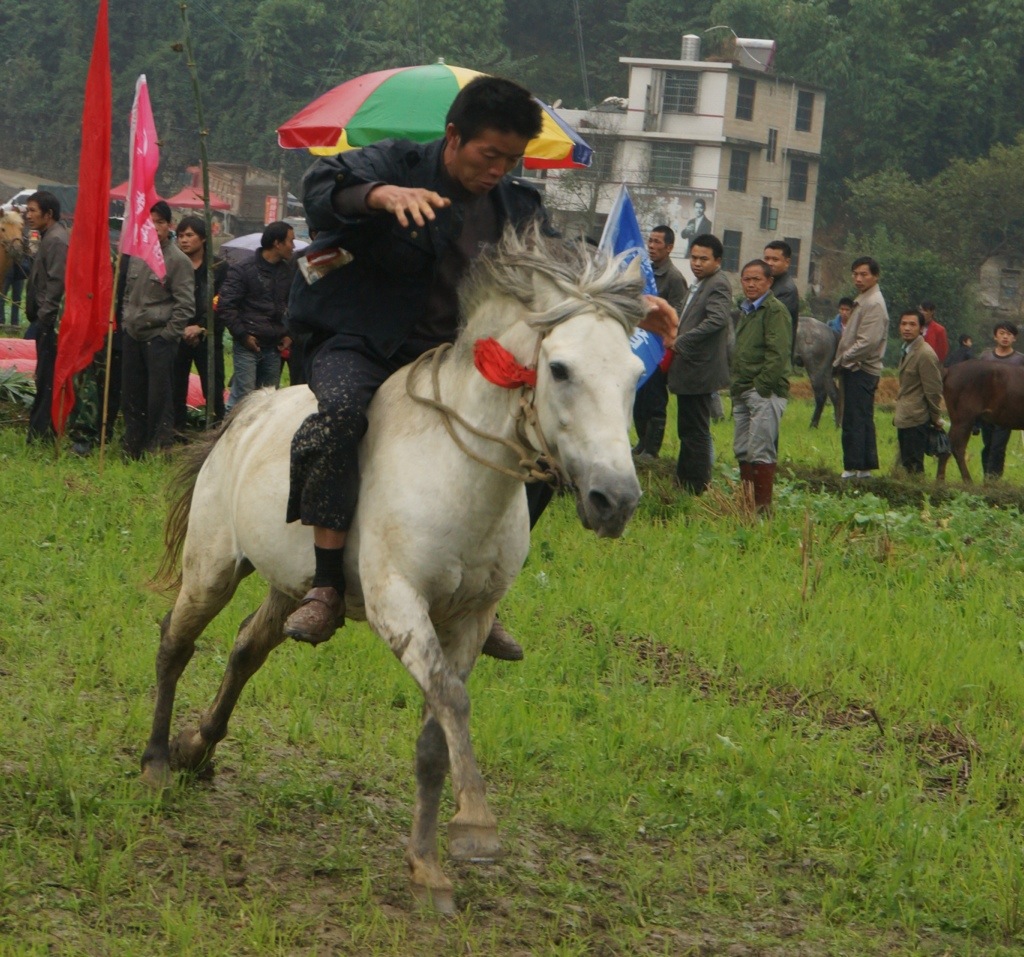
Blurred pictures capture some of the spirit of what we saw.
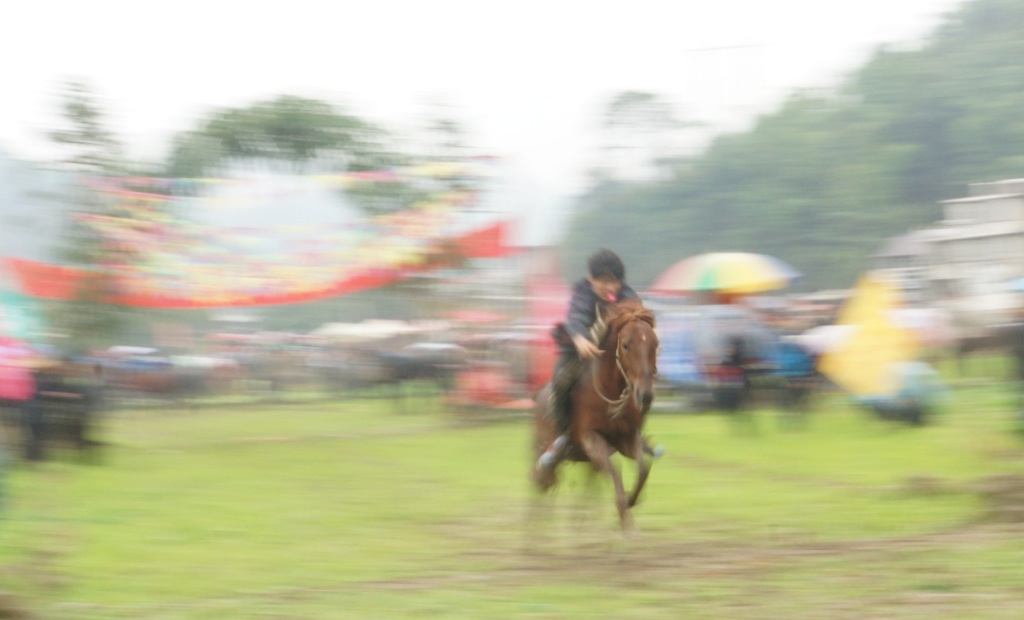
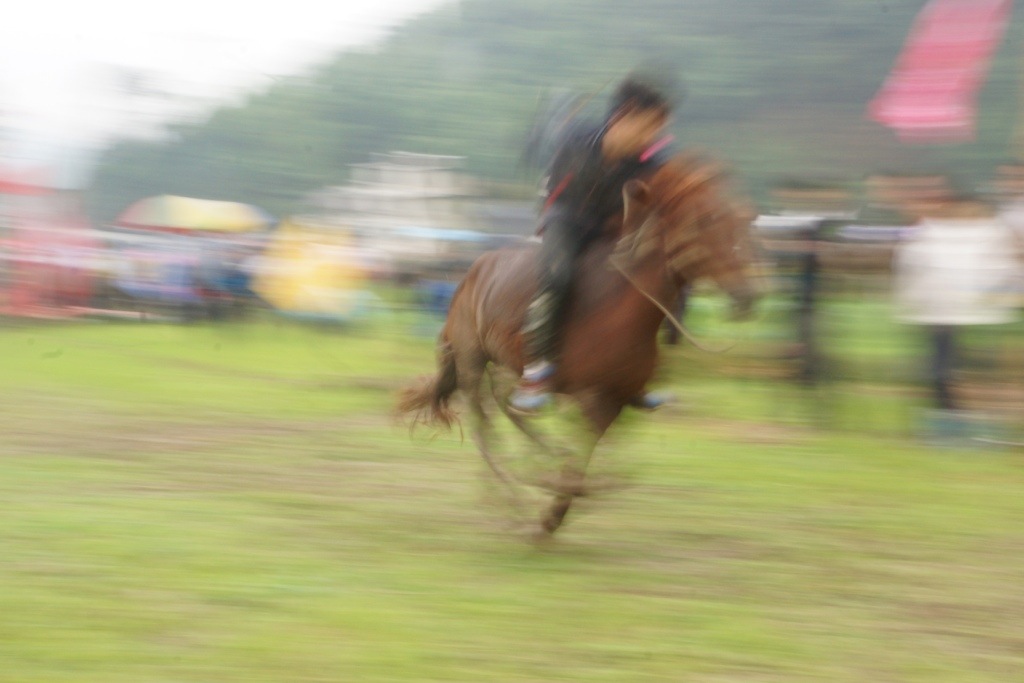
After the races, we slog back through the mud to the road, then up the road to the bus. We try to brush and wash some of the mud off our shoes with modest success. We ride the bus a couple hours to Kaili. Nevada reads interesting CNN reports on the transition in China’s government and on the presidential election.
At the Crowne Plaza Hotel in Kaili, we check in and rush up to the room for warm showers and to try to get some of the mud off our shoes and clothes. Across the street to a restaurant for another good Chinese dinner.
November 5
Breakfast at the hotel, then off to a Shui festival, stopping en route at a market of Shui and Miao people in the Sandu area. Market is in the town of Dujiang (jiang means “river”).
Oops, on the way to the market, we learn that a festival is taking place at another village, and we detour to go to the festival. This is typical of the organic way this trip develops. The village is Gaodong and we will see the white collar Miao people.
Okay, now, having been to the festival, I can report that it was amazing. It all came about because Lee was checking directions and a lady who the group nicknamed “Hurricane Helen” told him about the festival. Nicely dressed and wearing high heels, Helen hopped on our bus and directed us to the festival, where we were greeted by women with baijou, a liquor, in bowls and horns, which they poured into our mouths.

They placed a string with a pink egg cradled in red threads around each of our necks.
A group of young girls in costume sang for us.
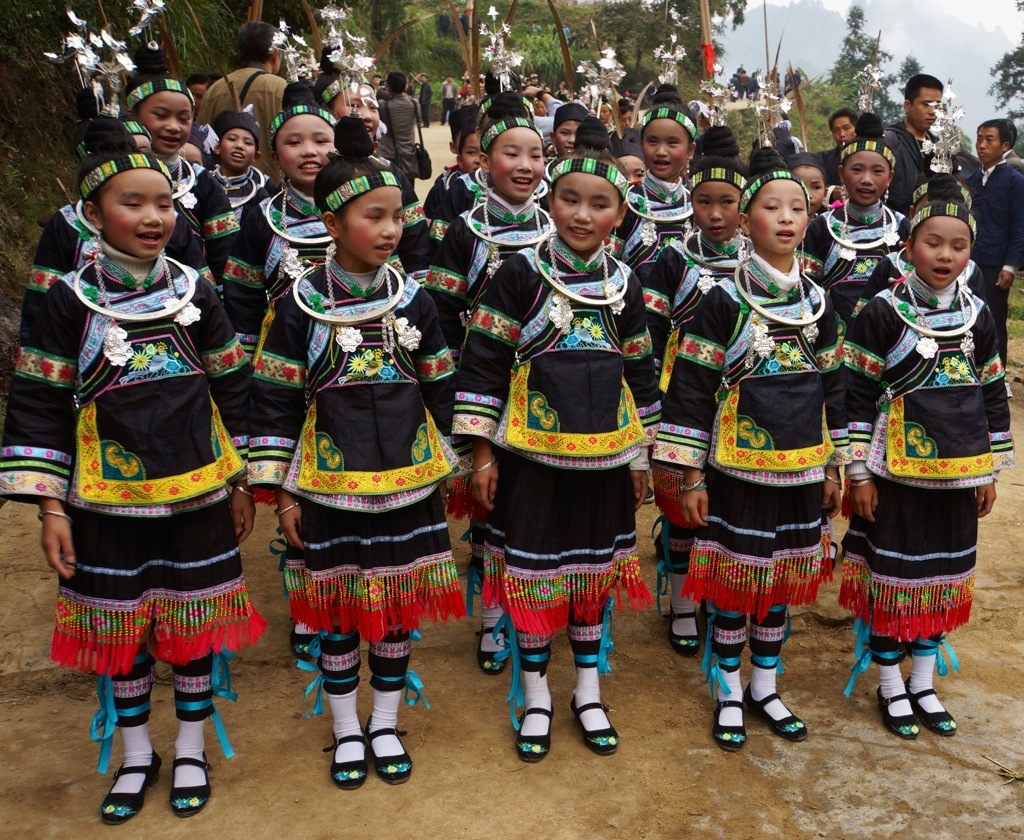
We were then herded up the hill by Hurricane Helen, past musicians and other costumed ladies. From there, Helen escorted us to the headman’s house, where we were served lunch, along with many Chinese visitors to the festival. Hurricane Helen is a force. You would not want to get in her way. Evidently, November is National Firecracker Month in Guizhou, because here, as elsewhere, firecrackers were fired off in constantly, rapid-fire, sounding like gun shots.
After lunch, we wandered down through crowds of people to two open areas, separated by a kind of moat. The place had a county fair atmosphere, with stands selling food and other items, balloons, cotton candy, etc. In one area, bull fighting would take place; on the other side of the moat, dancing. We opted to watch the dancing, along with thousands of others who sat or stood in tiers on the surrounding hillsides, creating a colorful backdrop to the festival.
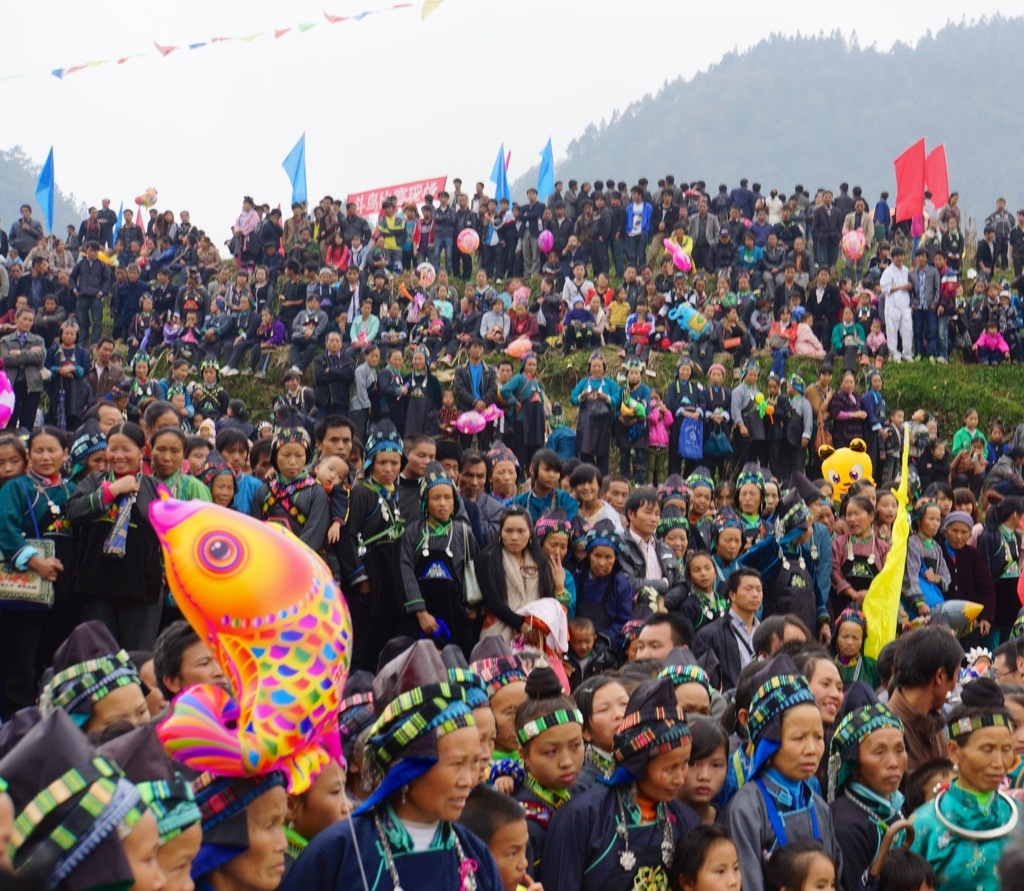
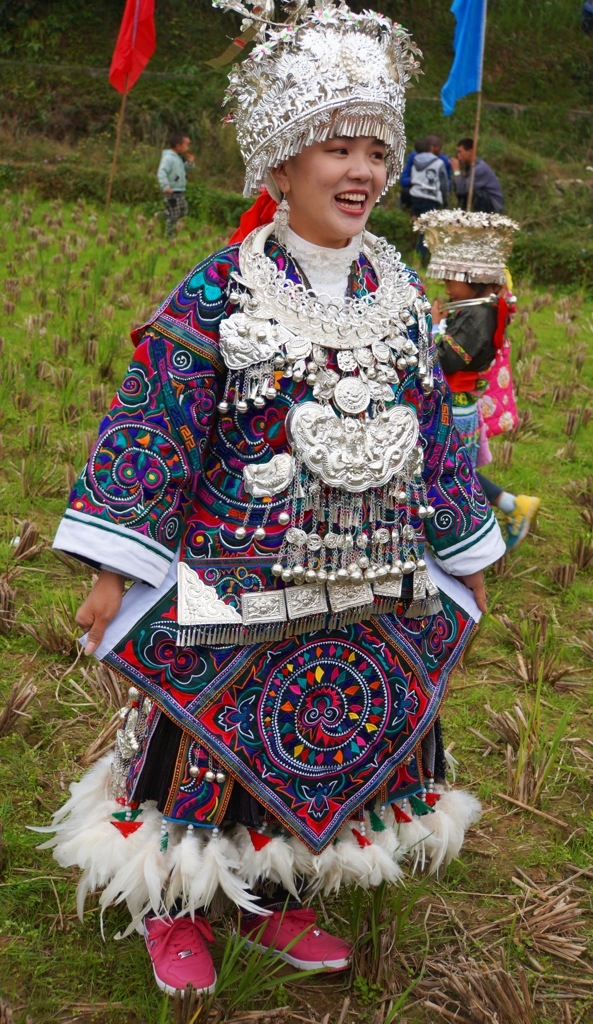
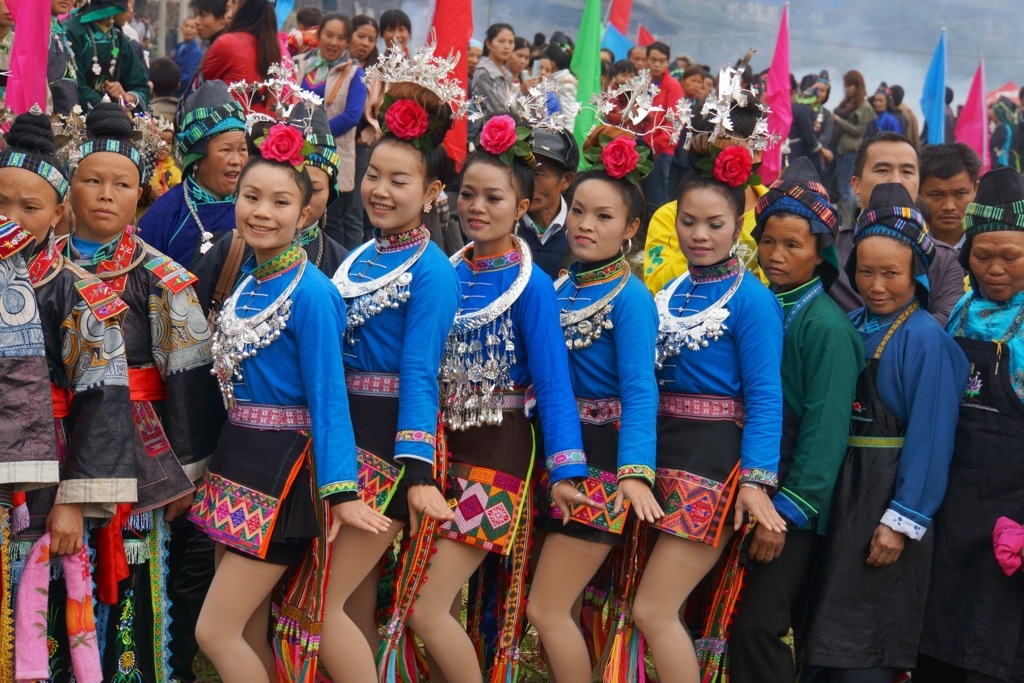
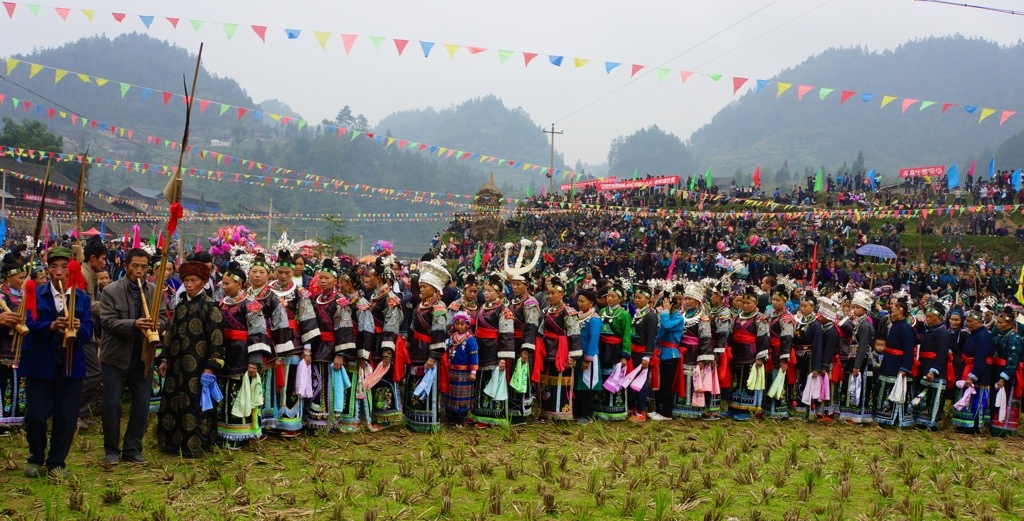
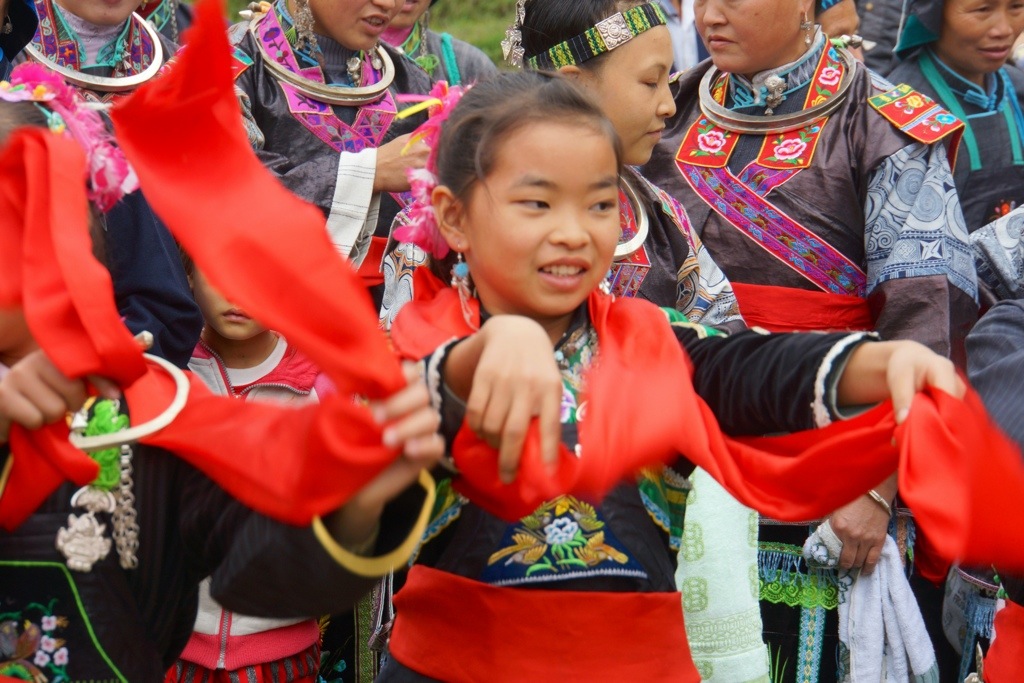
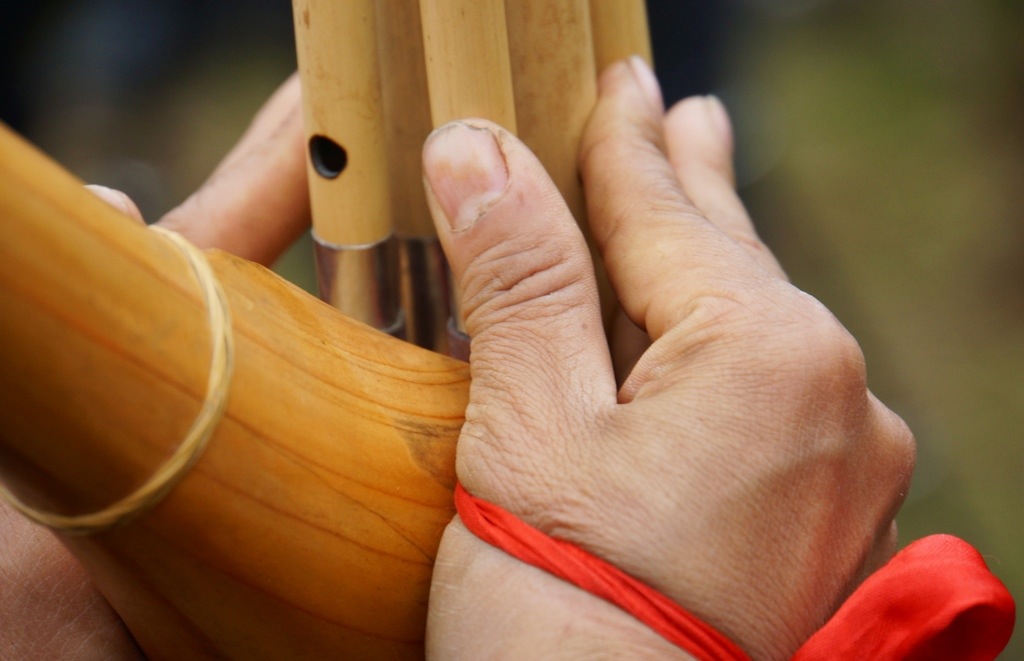
There were five or six different types of Miao people, all dressed in distinctive costumes, children and young and old women, dancing in circles to lusheng music and, later, to drums.
We were objects of some curiosity and were asked by many to pose for photos with their friends or family members. That was a fair trade, as the photographic opportunities for us were amazing. I wound up taking 362 photos for the day. (I discovered from talking to others later that I was definitely below what most took). There was ample time to experiment, as for example in two panning shots below, intentionally blurry, which you may or may not care for.
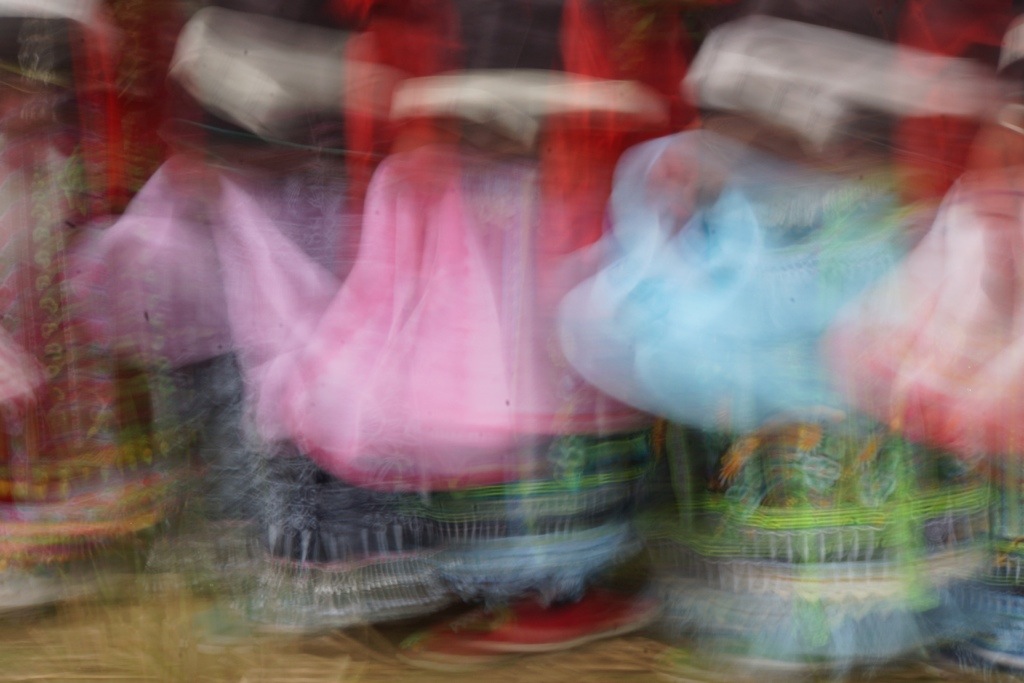
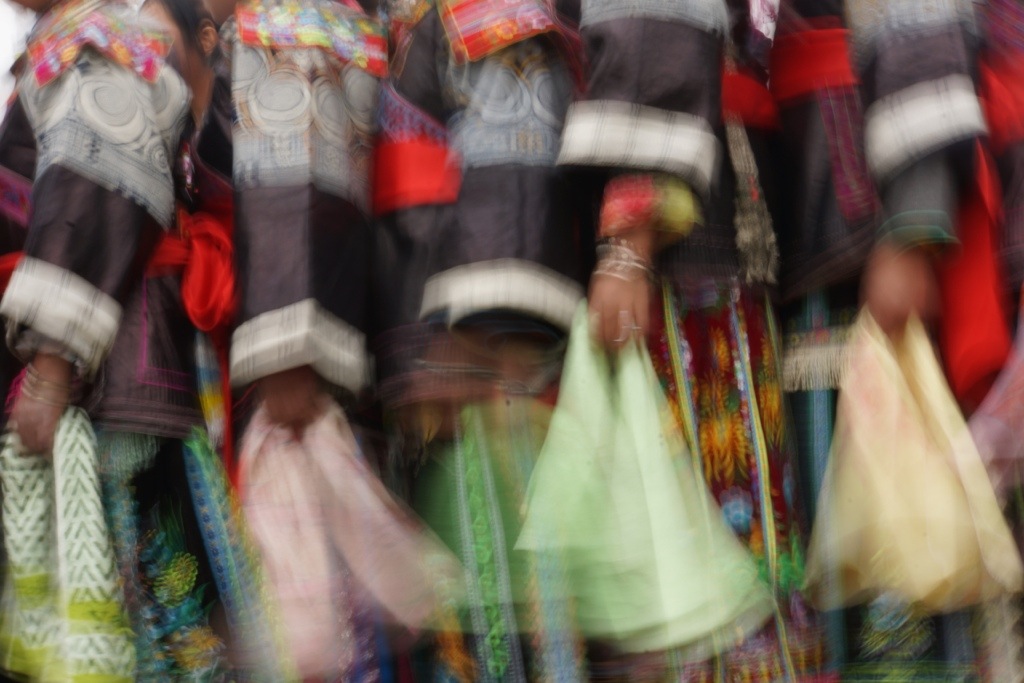
People were very friendly and a few of us were pushed into a dance line to participate, as I am here with the lusheng players.
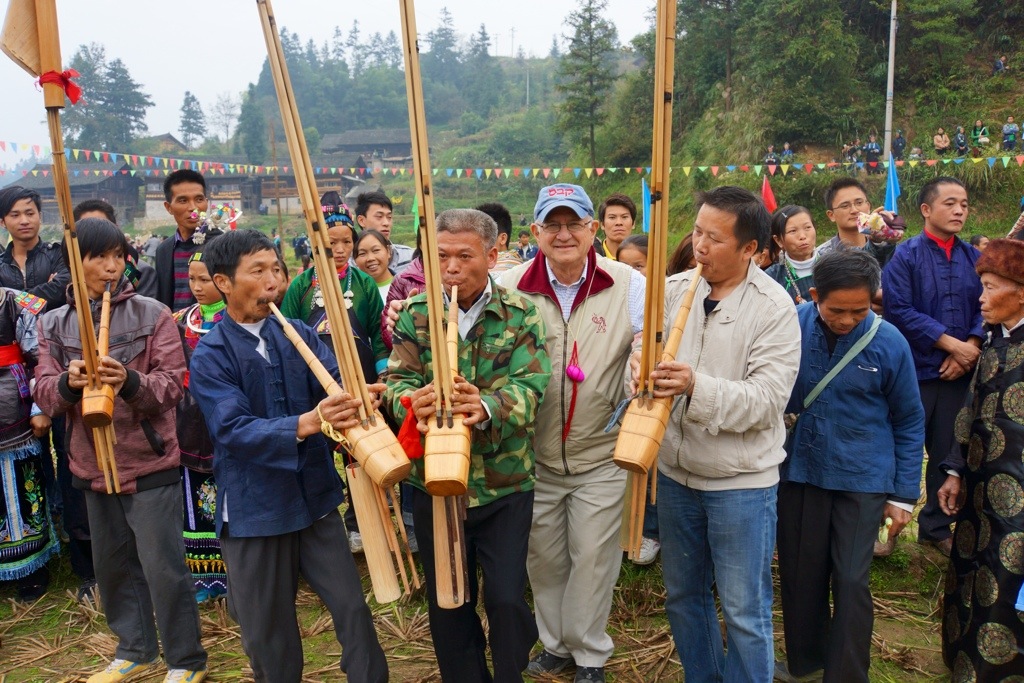
To put it mildly, it was quite a scene, totally different than the first festival we went to, which was more intimate, but seems very tame by comparison. Those who saw some of the bull fighting reported that the fighting at the first festival had been much better. Even, Nevada, who has been to many of these festivals in her seven trips to Guizhou was quite blown away by the day’s activities.
At a couple points, bulls escaped on the other side, jumped and climbed over the moat, scattering us and the rest of the crowd and dancers. Lee fell down as the first bull escaped, but four men helped her up immediately. After four hours or so, we made our way through the crowd (not an easy task) and back to the bus. For the first time, it began to drizzle, but we were able to find shelter and wait for our bus. Though I have not commented upon it, we’ve been incredibly fortunate with the weather so far.
We were scheduled to do a home stay tonight, but because of the six-hour unanticipated stop at the festival, we decided not to do the home stay, to the relief of all of us. While I’m sure the home stay would have been interesting /fun, at least in retrospect, this was a good night not to do one.
The hotel we are staying at in Sandu is quite fine, though I do have a walk up to my fourth floor room. Unlike at the guest house we stayed at several nights ago, which was a walk up to the third floor, I did not carry my luggage up, as I’m still paying a bit of a price in my back from the guest house (though it’s better today, after Sandy loaned me me the miracle spray that she bought in Beijing).
Out for dinner (yes, we tried Chinese again) at an excellent restaurant. I have to admit that, though I generally am not looking forward to going out to dinner, I’ve enjoyed them much more than I’ve expected to. Back to the hotel to finish the blog and download more photos. Also sprayed more of Sandy’s magic spray, which she bought for me at a pharmacy across from the hotel,
(Note: If you are reading this blog regularly, you may want to look back at yesterday’s post quickly, because some of the photos may have appeared after the time you saw it.)
|
|

















































